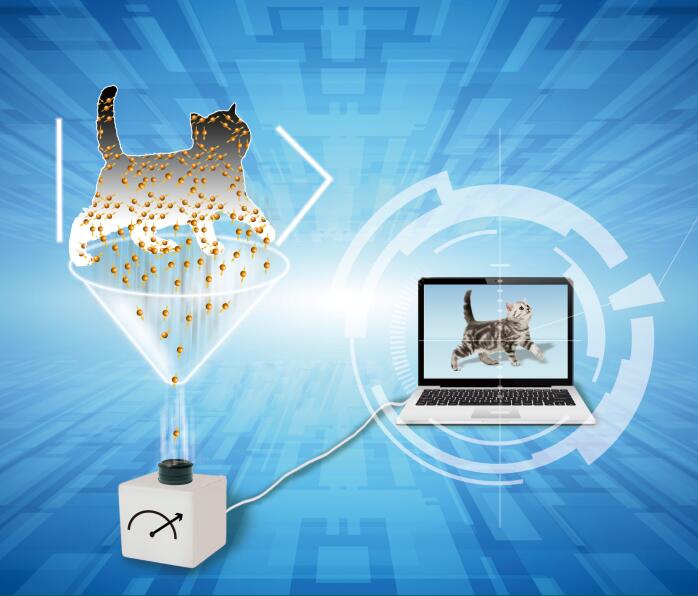SPECIAL TOPIC—Quantum computation and quantum information
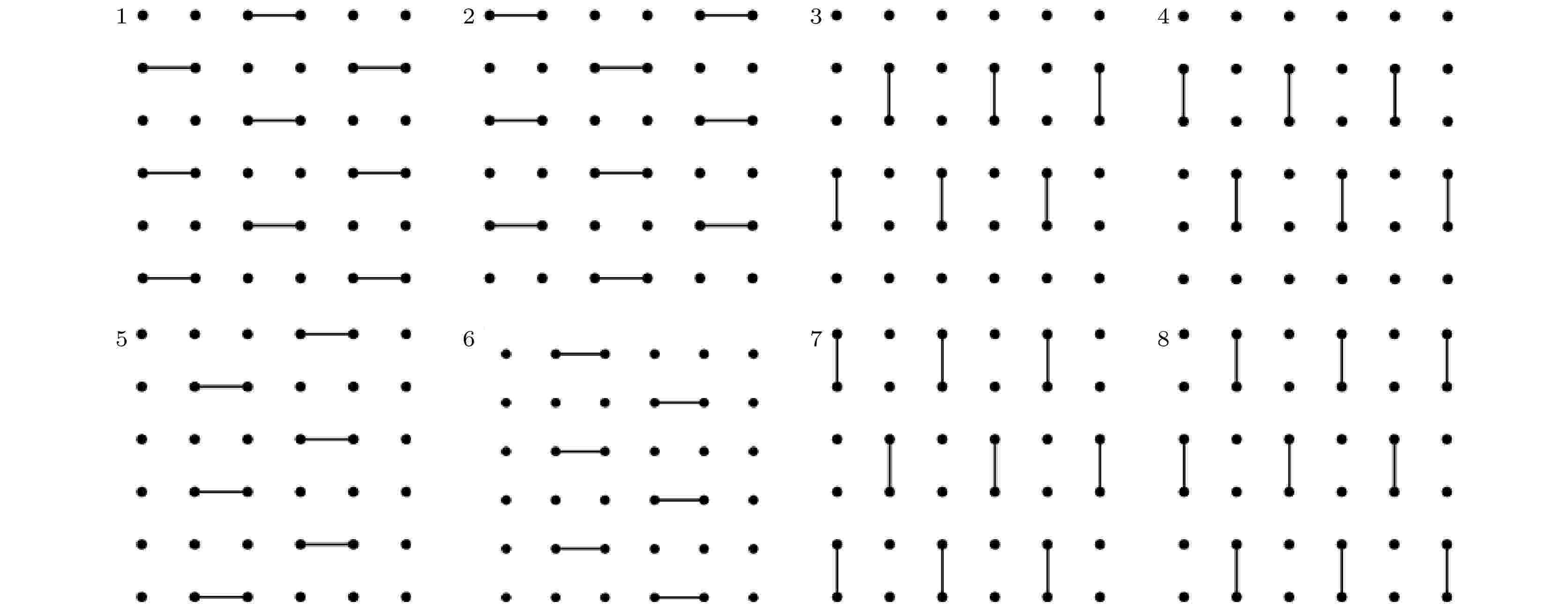
2021, 70 (21): 210201.
doi: 10.7498/aps.70.20211428
Abstract +
Exploiting the coherence and entanglement of quantum many-qubit states, quantum computing can significantly surpass classical algorithms, making it possible to factor large numbers, solve linear equations, simulate many-body quantum systems, etc., in a reasonable time. With the rapid development of quantum computing hardware, many attention has been drawn to explore how quantum computers could go beyond the limit of classical computation. Owing to the need of a universal fault-tolerant quantum computer for many existing quantum algorithms, such as Shor’s factoring algorithm, and considering the limit of near-term quantum devices with small qubit numbers and short coherence times, many recent works focused on the exploration of demonstrating quantum advantages using noisy intermediate-scaled quantum devices and shallow circuits, and hence some sampling problems have been proposed as the candidates for quantum advantage demonstration. This review summarizes quantum advantage problems that are realizable on current quantum hardware. We focus on two notable problems—random circuit simulation and boson sampling—and consider recent theoretical and experimental progresses. After the respective demonstrations of these two types of quantum advantages on superconducting and optical quantum platforms, we expect current and near-term quantum devices could be employed for demonstrating quantum advantages in general problems.
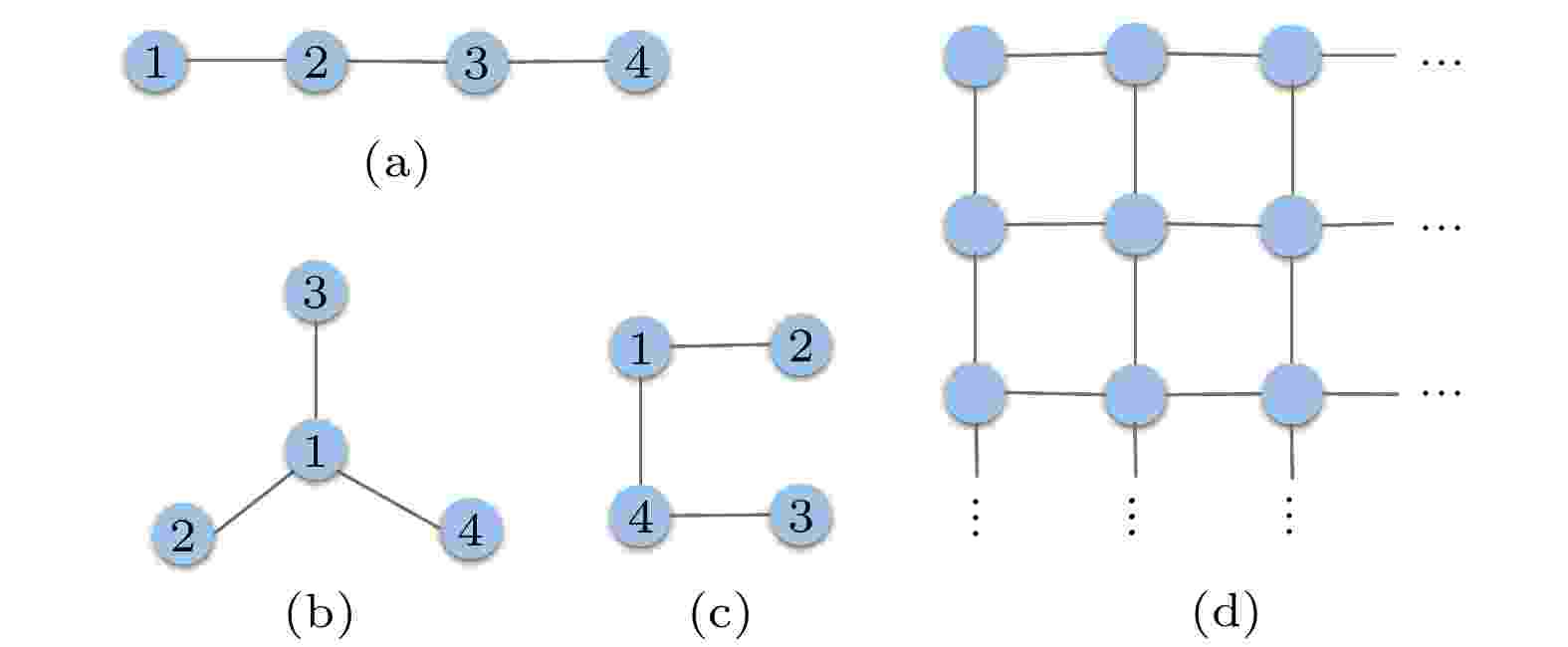
2021, 70 (21): 210301.
doi: 10.7498/aps.70.20210923
Abstract +
Compared with the quantum gate circuit model, the measurement-based quantum computing model provides an alternative way to realize universal quantum computation, and relevant contents have been greatly enriched after nearly two decades of research and exploration. In this article, we review the research history and status of the measurement-based quantum computing model. First, we briefly introduce the basic theories of this model, including the concept and working principles of quantum graph states as resource states, the model’s computational universality and classical simulation methods, and relevant applications in the field of quantum information processing such as designing quantum algorithms and fault-tolerant error correction schemes. Then, from the perspective of quantum physical properties, which include the specific roles of quantum entanglement, contextuality, quantum correlations, symmetry-protected topological order, and quantum phases of matter as computing resources, the close relationship between measurement-based quantum computing model and quantum many-body system is presented. For example, a type of measurement-based computing model for exploiting quantum correlations can show a quantum advantage over the classical local hidden variable models, or certain symmetry-protected topological order states enable the universal quantum computation to be conducted by using only the measurements of single-qubit Pauli operators. Next, a variety of different technical routes and experimental progress of realizing the measurement-based quantum computing model are summarized, such as photonic systems, ion traps, superconducting circuits, etc. These achievements in various physical areas lay the foundation for future scalable and fault-tolerant quantum computers. Finally, we discuss and prospect the future research directions in this field thereby inspiring readers to further study and explore the relevant subjects.

2021, 70 (21): 210302.
doi: 10.7498/aps.70.20210985
Abstract +
Quantum computing, as an emerging computing paradigm, is expected to tackle problems such as quantum chemistry, optimization, quantum chemistry, information security, and artificial intelligence, which are intractable with using classical computing. Quantum computing hardware and software continue to develop rapidly, but they are not expected to realize universal quantum computation in the next few years. Therefore, the use of quantum hardware to solve practical problems in the near term has become a hot topic in the field of quantum computing. Exploration of the applications of near-term quantum hardware is of great significance in understanding the capability of quantum hardware and promoting the practical process of quantum computing. Hybrid quantum-classical algorithm (also known as variational quantum algorithm) is an appropriate model for near-term quantum hardware. In the hybrid quantum-classical algorithm, classical computers are used to maximize the power of quantum devices. By combining quantum computing with machine learning, the hybrid quantum-classical algorithm is expected to achieve the first practical application of quantum computation and play an important role in the studying of quantum computing. In this review, we introduce the framework of hybrid quantum-classical algorithm and its applications in quantum chemistry, quantum information, combinatorial optimization, quantum machine learning, and other fields. We further discuss the challenges and future research directions of the hybrid quantum-classical algorithm.
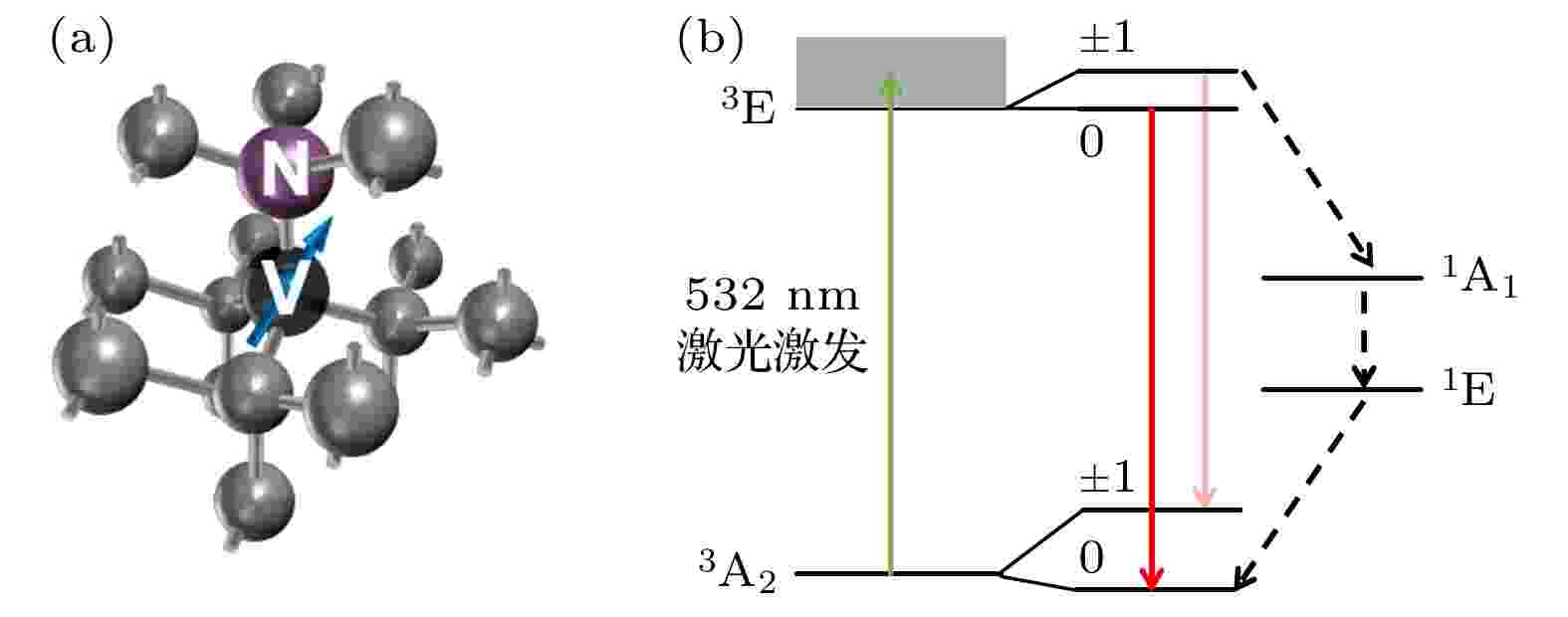
2021, 70 (21): 213301.
doi: 10.7498/aps.70.20211363
Abstract +
Characterizing the properties of matter at a single-molecule level is highly significant in today’s science, such as biology, chemistry, and materials science. The advent of generalized nanoscale sensors promises to achieve a long-term goal of material science, which is the analysis of single-molecule structures in ambient environments. In recent years, the nitrogen-vacancy (NV) color centers in diamond as solid-state spins have gradually developed as nanoscale sensors with both high spatial resolution and high detection sensitivity. Owing to the nondestructive and non-invasive properties, the NV color centers have excellent performance in single-molecule measurements. So far, the NV centers have achieved high sensitivity in the detection of many physical quantities such as magnetic field, electric field, and temperature, showing their potential applications in versatile quantum sensors. The combination with the cross measurements from multiple perspectives is conducible to deepening the knowledge and understanding the new substances, materials, and phenomena. Starting from the microstructure of NV sensors, several detections under the special magnetic field condition of zero field, including zero-field paramagnetic resonance detection and electric field detection, are introduced in this work.
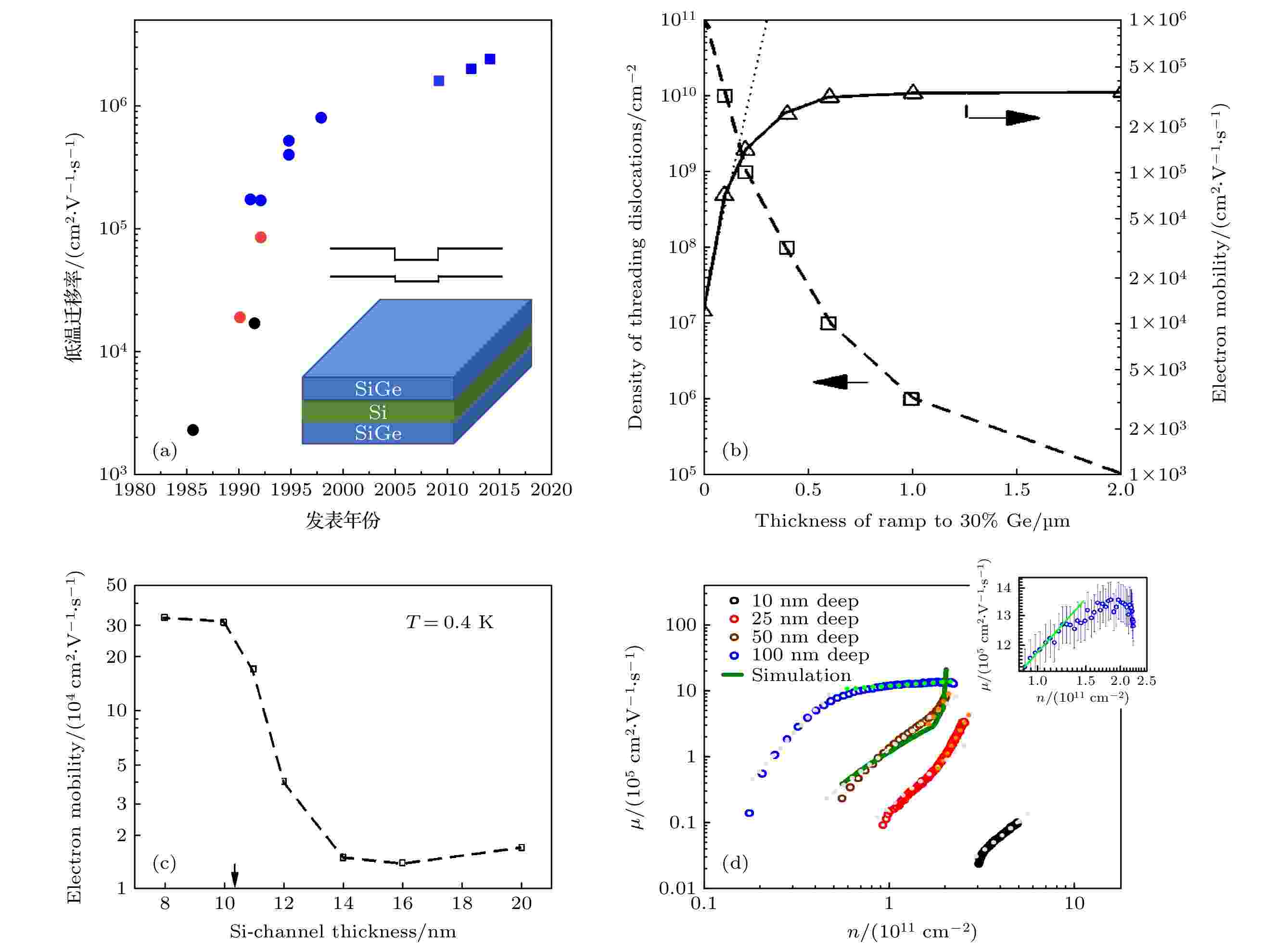
2021, 70 (21): 217802.
doi: 10.7498/aps.70.20211492
Abstract +
Semiconductor quantum dot is one of the promising ways to realize solid-state quantum computing. The key is to obtain high-quality semiconductor quantum computing materials. Silicon and germanium can be isotopically purified to achieve nuclear spin-free isotopes, meeting the requirement for long decoherence time. They are also compatible with the current CMOS technology, thus making them ideal material platforms for large scale integration. This review first summarizes the important progress of semiconductor quantum-dot quantum computing in recent years, then focuses on the material progress including the silicon-based Si/SiGe heterostructures, Ge/SiGe heterostructures, and Ge/Si one-dimensional wires, finally presents the outlook about the development of silicon and Ge quantum computing materials.

COVER ARTICLE
2021, 70 (21): 210303.
doi: 10.7498/aps.70.20211066
Abstract +
Quantum state measurement is essential for reading-out a quantum computing outcome. Meanwhile, the readout results are always affected by the large noise of quantum measurements in physical implementation, which also hinders the large-scale expansion of quantum computing. In light of this, we present an indirect quantum state readout method based on a single ancilla qubit that can avoid the large noise of multiple-qubit measurements. The theoretical analysis and simulations indicate that our method is more robust against the measurement noise and promises to become a method of large-scale quantum error correction and high-fidelity quantum state readout.
REVIEW
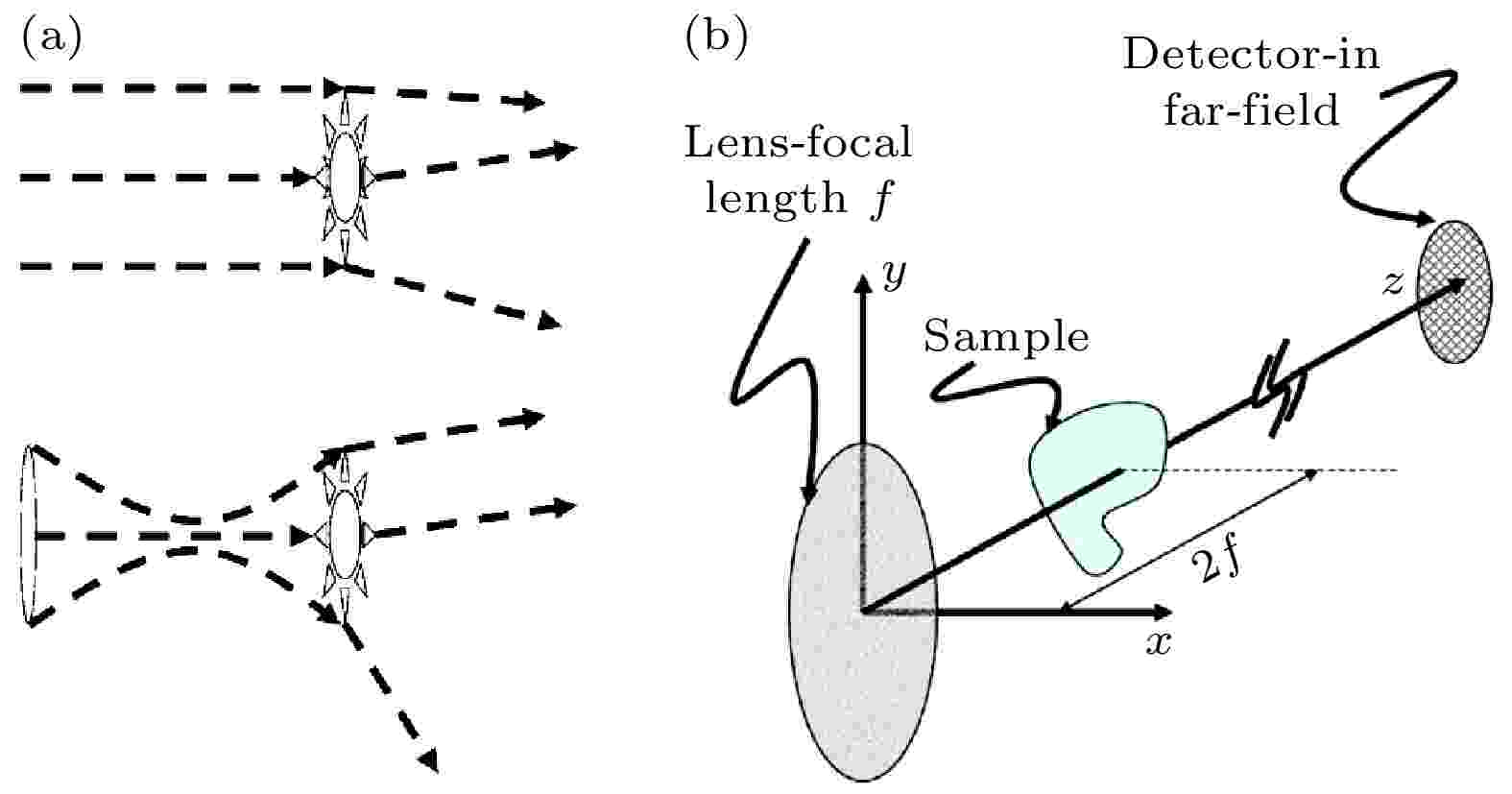
EDITOR'S SUGGESTION
2021, 70 (21): 214201.
doi: 10.7498/aps.70.20211020
Abstract +
Coherent diffraction imaging (CDI), a type of lensless imaging method, relies on the use of light source with high-degree coherence to compute highly resolved complex-valued objects. The coherence of light source consists of temporal coherence and spatial coherence. In practice, it is difficult to obtain a fully coherent source. Spatial decoherence can be generated in the following three scenarios: no synchronization mechanism for the whole radiation source, a finite (non-zero) point spread function of the detector, and the sample variation within exposure time. Partial temporal coherence means that the beam is not quasi-monochromatic, behaving as the energy spread of the illumination. The consequence of reduced degree of temporal and/or spatial coherence in CDI is the decrease of visibility in the measured diffraction intensity. A fundamental assumption of CDI is the full temporal and spatial coherence, and even a relatively small deviation from full coherence can prevent the phase retrieval algorithm from converging accurately. It is necessary to break the barrier of limited coherence by improving the experimental setups directly or optimizing the phase retrieval algorithms to mitigate decoherence. Based on the Wolf’s model of coherence-mode of light and the framework of CDI using partially coherent light proposed by Nugent et al., various methods have been proposed to solve the problems induced by low coherence. Those methods generally experience a similar development process, that is, from the requirement for measuring the spatial (coherent length or complex coherent factor) or temporal (spectrum distribution) coherence properties to without the need for such priori knowledge. Here in this work, the principles of partial coherent CDI, and the major progress of CDI with partial spatial- and temporal-coherent light are reviewed.
GENERAL
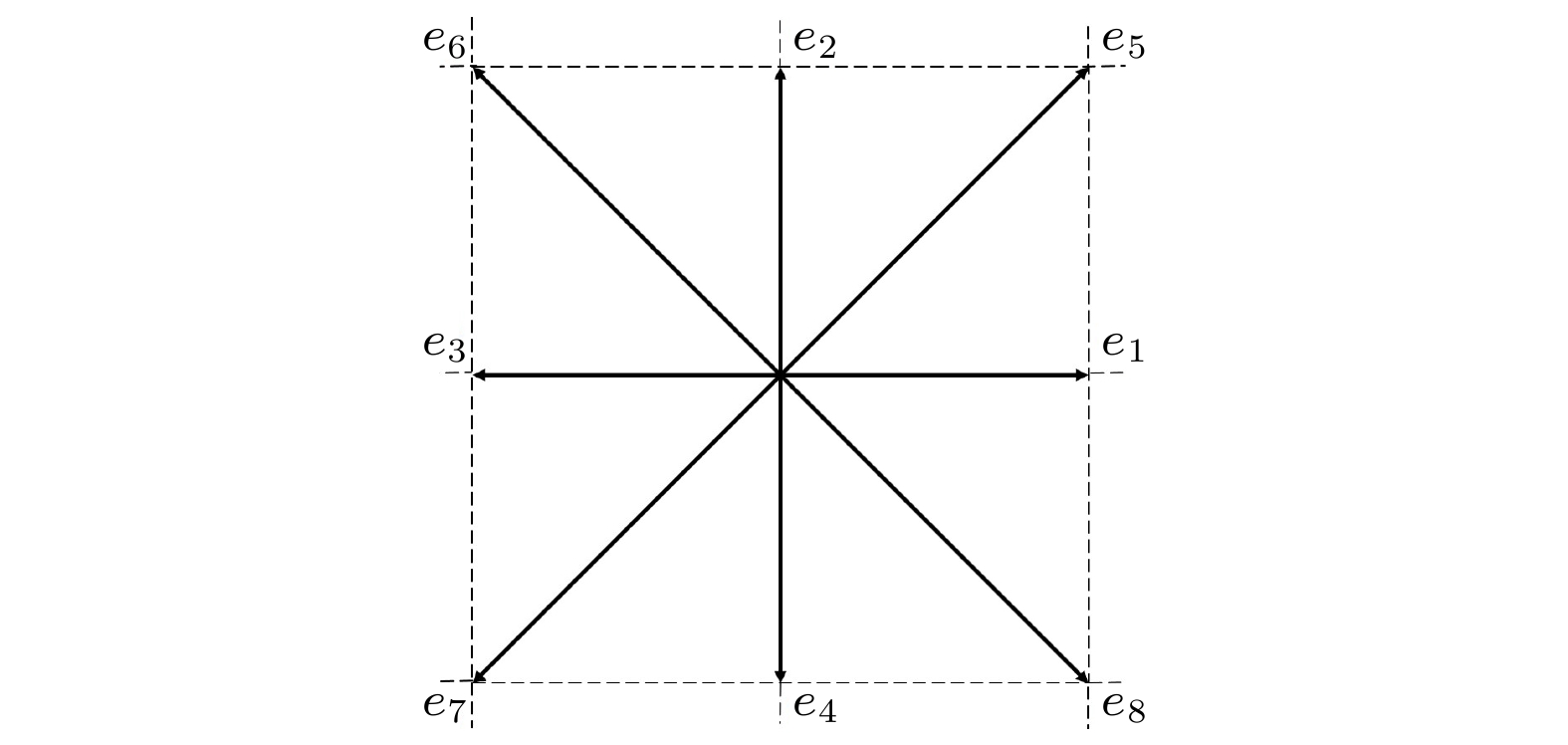
2021, 70 (21): 210501.
doi: 10.7498/aps.70.20210514
Abstract +
The lymphatic system plays an important part in the body’s immunity and cell’s internal environment homeostasis. Like a blood circulatory system, the lymphatic system is a piping system throughout the body, which is composed mainly of lymphatic fluid and lymphatic vessels. The spontaneous contraction of the lymphatic vessels drives the flow of lymphatic fluid in the vessels. The spontaneous contraction-relaxation mechanism of lymphatic vessels is determined by the oscillating feedback of Ca2+ concentration and NO concentration. The distribution of NO in the vessels plays an important role in the contraction cycle of lymphatic vessels. The shear force acting on the lymphatic valves due to the flow of fluid is the main source of NO. In a real system, the distribution of NO in a certain section of lymphatic vessel will be affected by other lymphanion connected to it, especially the upstream connecting fragments. Through the lattice Boltzmann method, a multi-segment lymphatic vessel model with valve structure is established, which reproduces the feedback mechanism of Ca2+ and NO, valve change and fluid flow. There are three types of lymphatic vessels in the model, namely the initial lymphatic vessel, the collecting lymphatic vessel, and the outlet lymphatic vessel. The number of lymphatic vessels can be unlimited and inputted by the parameters. The number of lymphatic vessels is 3-5, and there are two pairs of valves in each lymphatic vessel. In this paper studied are the distribution of NO and pressure in multi-segment lymphatic vessel, and the change in the flow of each vessel in the three-segment vessel model over time.
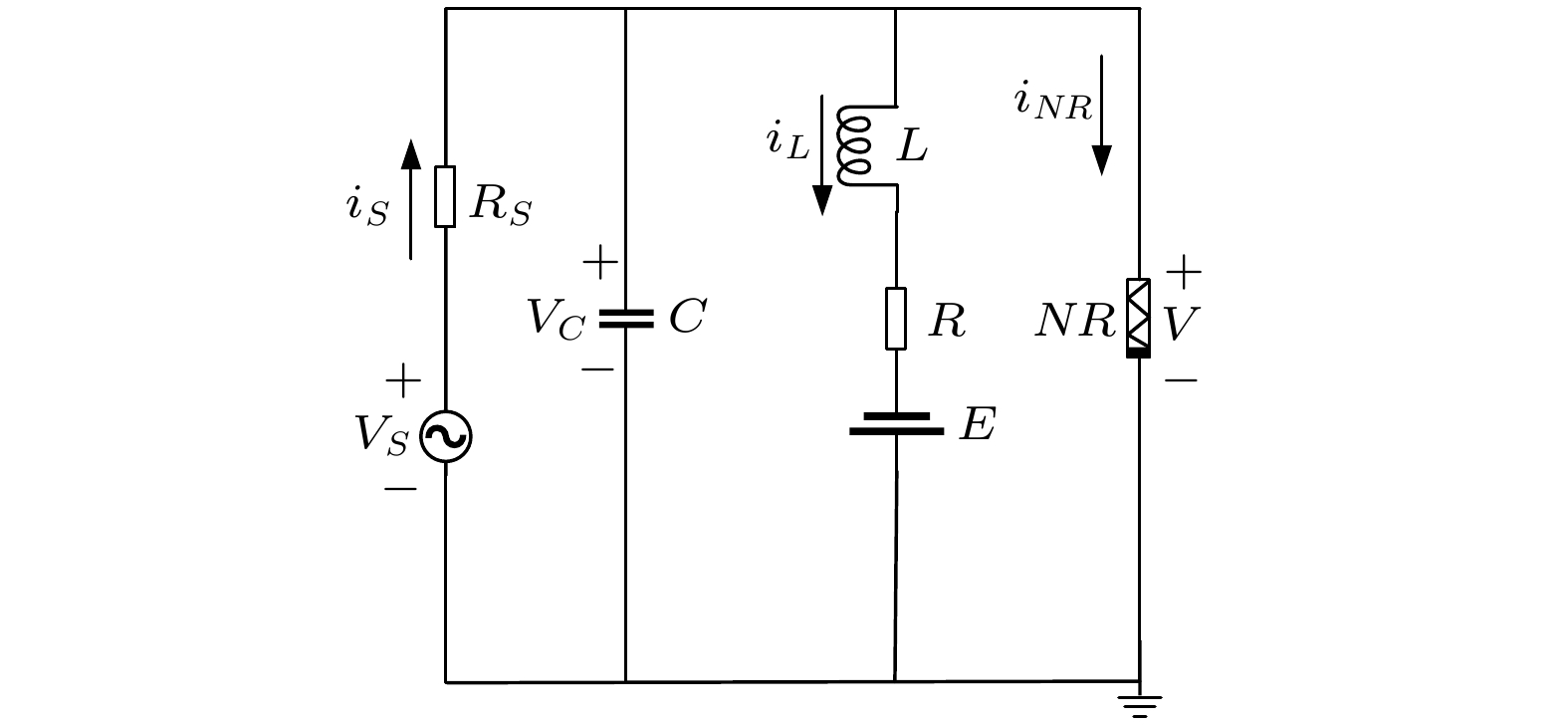
2021, 70 (21): 210502.
doi: 10.7498/aps.70.20210676
Abstract +
Firing patterns discern the electrical activities in biological neurons when intracellular and extracellular ions are pumped into cells and exchanged there. Artificial neural circuits can be tamed to reproduce similar firing modes from biological neurons by applying appropriate physical stimuli. Photocurrent generated in the phototube can be used as a signal source, which can stimulate the neural circuits, while the involvement of which branch circuit will be much different because the channel current can control the dynamics of functional neuron to a different degree. In this paper, based on a nonlinear (FitzHugh-Nagumo, FHN) neural circuit composed of one capacitor, induction coil, nonlinear resistor, two ideal resistors and one periodical stimulus, the phototube is incorporated into different branch circuits for changing the channel current and the biophysical role of photocurrent is investigated. The dynamical equations of three types of system are unified, though they fall in different areas in parameter space. The membrane potential can be directly changed and firing modes are switched when photocurrent is activated to change the channel current by connecting the phototube to the capacitor. The induced current across the induction coil is regulated to balance the external stimulus when the phototube is connected to the induction coil in series. The two types of photosensitive neuron models constructed in this paper are compared with the photocurrent driven inductive branch showing that the photocurrent driven capacitive branch can very effectively regulate the membrane potential and greatly improve the photosensitive sensitivity.
ATOMIC AND MOLECULAR PHYSICS
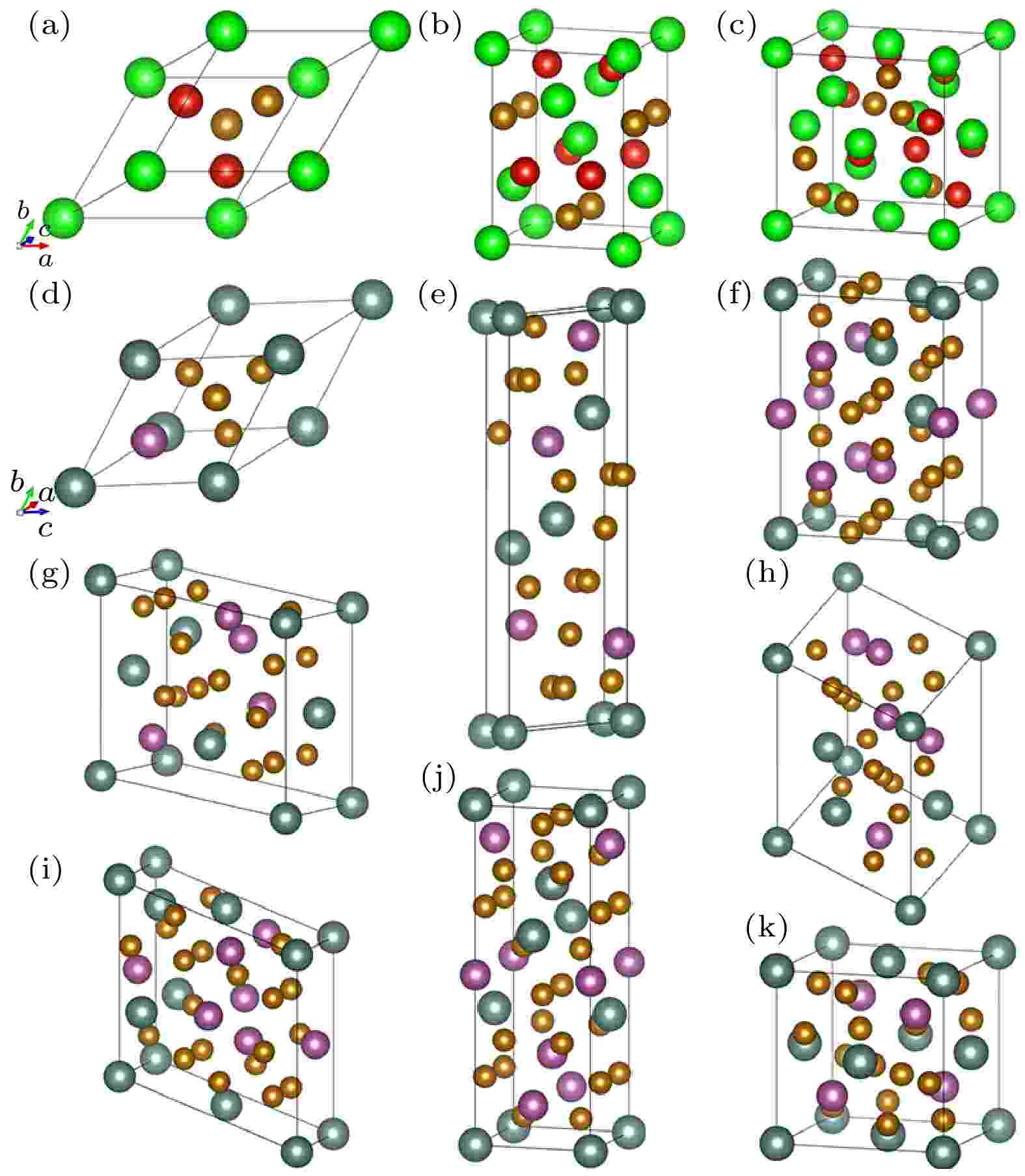
EDITOR'S SUGGESTION
2021, 70 (21): 213601.
doi: 10.7498/aps.70.20210998
Abstract +
Alloying is an important way to increase the diversity of material structure and properties. In this paper, we start from Ising model considering nearest neighbor interaction, in which a ferromagnetic system corresponds to a low temperature phase separation and high temperature solid solution of binary alloy, while antiferromagnetic system corresponds to a low temperature ordered solid solution and a high temperature disorder. The high-throughput first-principles calculation based on the structure recognition is realized by the program SAGAR (structures of alloy generation and recognition) developed by our research group. By considering the contribution of structural degeneracy to the partition function, theoretical prediction of alloy materials can be carried out at finite temperature. Taking hydrogen storage alloy (ScxY1–x Fe2 and V2x Fe2(1–x)Zr) for example, the formation energy of ground state (at zero temperature) can be obtained by the first-principles calculations. It is found that the formation energy of ScxY1–x Fe2 is greater than zero, thereby inducing the phase separation at low temperature. The free energy will decrease with the temperature and concentration increasing, where the critical temperature of solid solution of alloy is determined according to the zero point of free energy. The formation energies of V2x Fe2(1–x)Zr are all lower than zero, and the ordered phase occurs at low temperature. The order-disorder transition temperature of V0.5Fe1.5Zr and V1.5Fe0.5Zr are both about 100 K, while the transition temperature of VFeZr is nearly 50 K. The calculation process will effectively improve the high throughput screening efficiency of alloy, and also provide relevant theoretical reference for experimental research.
ELECTROMAGNETISM, OPTICS, ACOUSTICS, HEAT TRANSFER, CLASSICAL MECHANICS, AND FLUID DYNAMICS
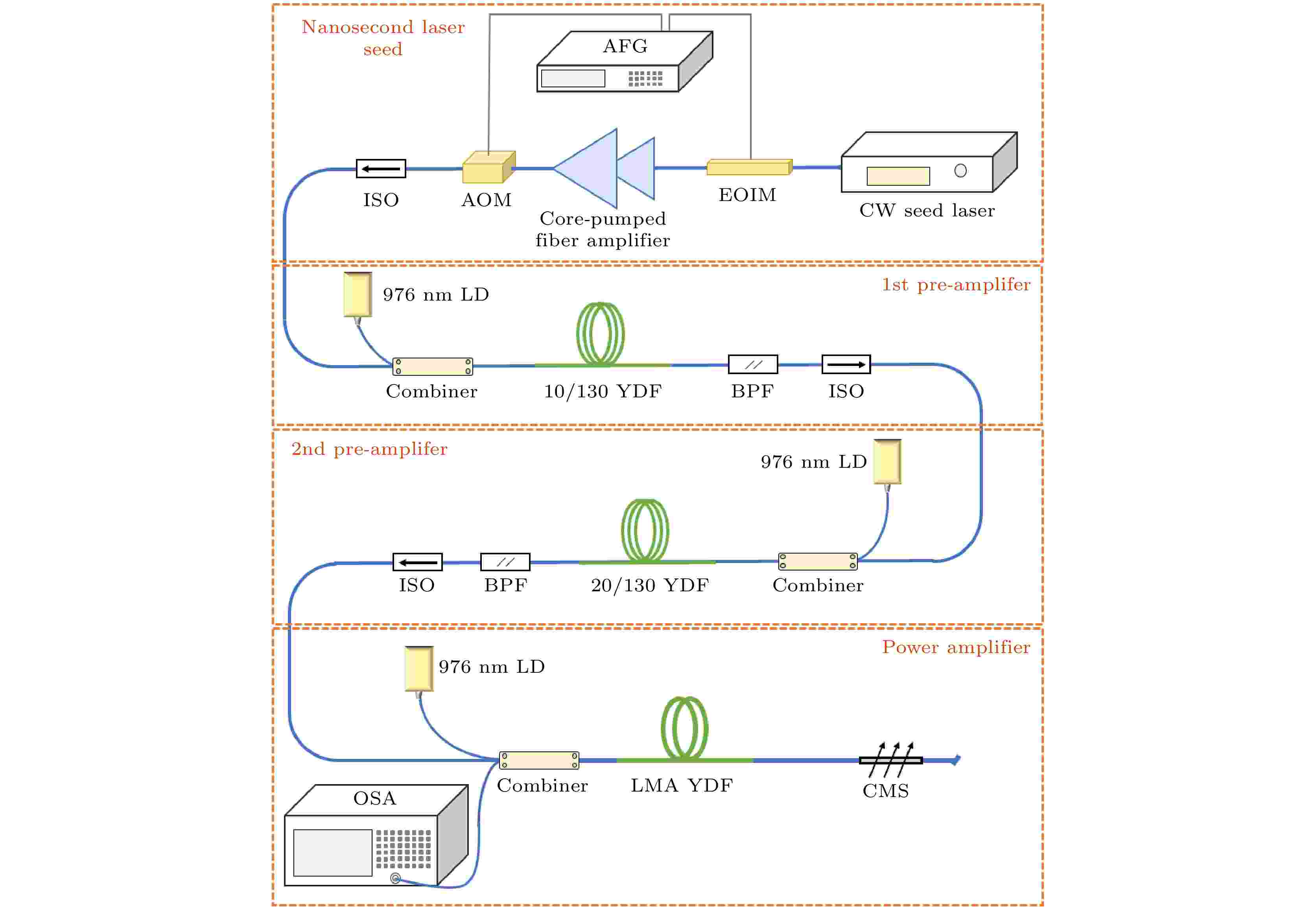
2021, 70 (21): 214202.
doi: 10.7498/aps.70.20210496
Abstract +
Fiber laser system in master oscillator power amplifier (MOPA) scheme is a promising technique for high-power narrow-linewidth laser output. With modulation-generated pulsed seed laser, the fiber MOPA benefits the flexible temporal behavior. However, the spectral linewidth broadening induced by self-phase modulation (SPM) is the main obstacle to achieving high-power single-frequency laser output with narrow spectral linewidth, especially for pulsed fiber MOPA in which the kilowatts level peak power results in strong nonlinearity. The SPM induced linewidth broadening is related to the derivative of light intensity with respect to time (dI/dt). Theoretically, if the dI/dt of the laser pulse is a constant, the SPM process will not generate any new frequency components. Hence, the linewidth broadening can be suppressed. In this work, we demonstrate a high-power single-frequency Yb fiber amplifier at 1064 nm, in which a sawtooth laser pulse is employed to suppress the SPM induced linewidth broadening, for obtaining the output with near-transform-limited narrow linewidth. The sawtooth-shaped seed pulse train is generated through using an electro-optic intensity modulator to modulate the continuous-wave (CW) output of a single-frequency fiber laser. After being pre-amplified, the seed laser with a pulse repetition rate of 20 kHz is coupled into the main amplifier, in which a piece of 0.9-m-long Yb-doped silica fiber with core and clad diameters of 35 μm and 250 μm, respectively, is used as a gain medium. The seed laser is enhanced to an average power value of 3.13 W under a launched 976-nm pump power value of 11.3 W before the onset of stimulate Brillouin scattering. The pulse energy 157 μJ and the pulse width 6.5 ns give a peak power of 24 kW. The spectral linewidth measured using a scanning Fabry-Perot interferometer at the maximum power is only 83 MHz, which is quite close to the 76-MHz transform-limited linewidth of the 6.5-ns sawtooth-shaped pulse. For comparison, we also conduct an experiment with a common Gaussian-shaped seed laser, in which the spectral linewidth is broadened significantly with a peak power value of only 1.5 kW. The results here reveal that the using of the sawtooth-shaped pulse is a promising technique to suppress the SPM induced spectral linewidth broadening in high-peak-power fiber amplifiers and acquire near-transform-limited narrow-linewidth laser output.
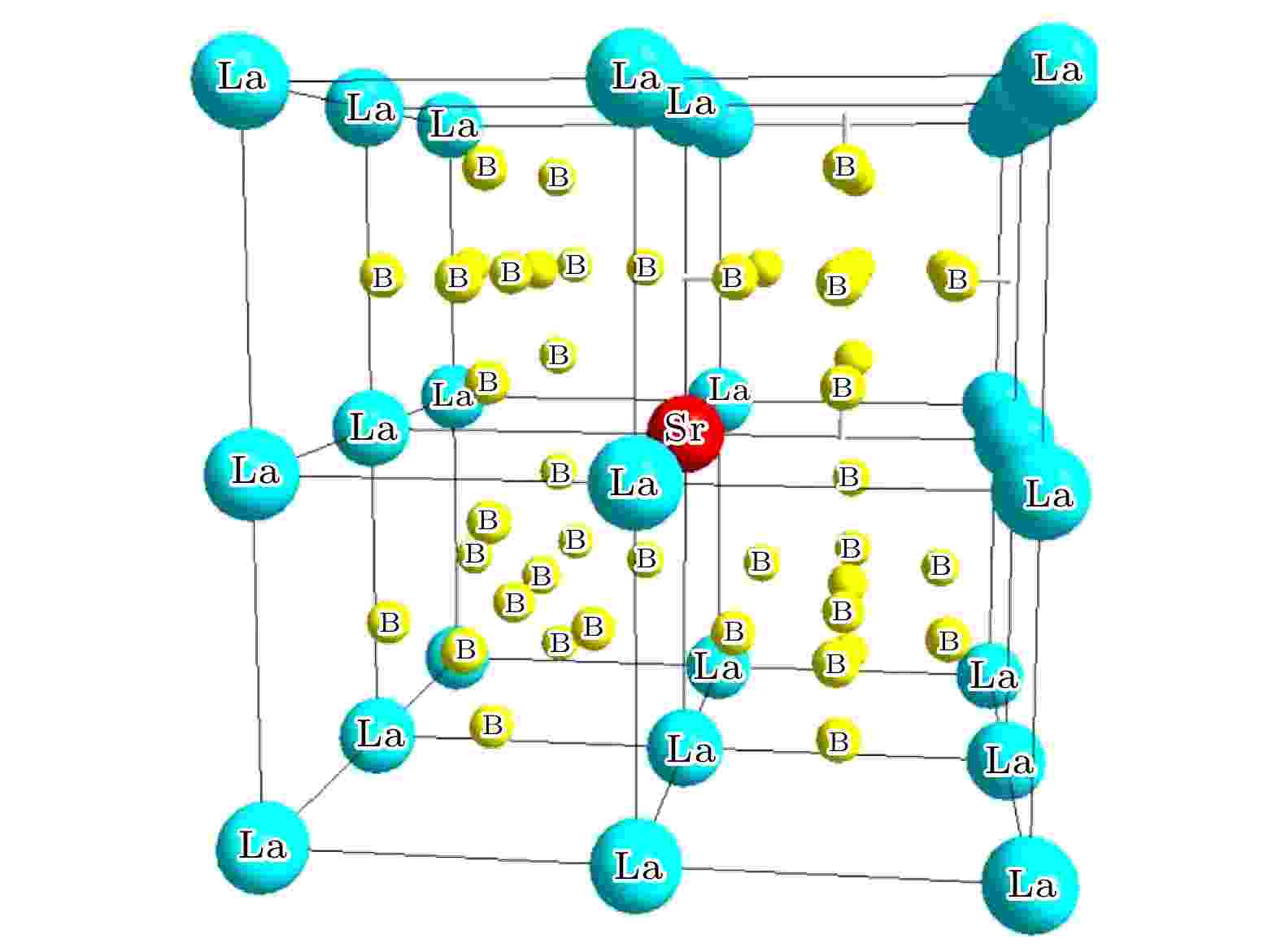
2021, 70 (21): 214204.
doi: 10.7498/aps.70.20211069
Abstract +
The optical absorption property of the nanocrystalline La1–x Srx B6 powder and thermionic emission property of the La1–x Srx B6 polycrystalline bulk are investigated. As a result, the transmission wavelength of LaB6 is red-shifted from 591 nm to 658 nm with the increase of Sr doping content. The emission tests indicate that the thermionic emission current density of La1–x Srx B6 polycrystalline bulk increases from 2.3 A/cm2 to 19.36 A/cm2 with the increase of La doping content under an applied voltage of 2000 V. The first-principle calculation results reveal that Sr doping LaB6 leads plasma frequency energy and Fermi level to decrease, resulting in the tunable characteristics of transmission wavelength and enhancement of thermionic emission. Therefore, the Sr-doped LaB6 as a multifunctional ceramic has a potential application in the field of optical filter or becomes a promising cathode for microwave device.

EDITOR'S SUGGESTION
2021, 70 (21): 214205.
doi: 10.7498/aps.70.20210367
Abstract +
A set of 4000-meter laser Doppler hydrothermal velocity measurement prototype suitable for deep sea in-situ measurement is developed in this work. In the system, an integrated design is adopted. The system is composed of a light source module, an optical module, and a Doppler signal processing module. The system is encapsulated in a pressure chamber with L500 mm × Φ205 mm to form an integrated optical measuring probe. An optical path of two-beam laser Doppler velocity measurement with strong local oscillator is proposed. The prototype is used to measure the simulated velocity in the laboratory. The measurement range is 0.01–10 m/s, and the flow velocity measurement resolution is 0.001 m/s. The experimental results preliminarily prove the feasibility of the laser Doppler velocity measurement system. After that, a withstanding voltage test on the system is conducted at the Qingdao Deep Sea Base, and the system obtains a normal signal under a high pressure of 40 MPa. A speed comparison measurement is carried out at the China Institute of Water Resources and Hydropower Research. In a low speed range from 0.01 m/s to 0.2 m/s, comparing with the acoustic Doppler velocity meter, the maximum measurement relative error is –9.43%. In a high speed range from 0.8 m/s to 9.6 m/s, comparing with the nozzle standard flow rate system, the maximum relative measurement error is –1.65%. The prototype system is tested in a shallow sea in Lingshui, Hainan. The sinking speed of the prototype system that sinks together with a crane down to a water depth of 50 m, and the towing speed of the system together with the ship at a depth of 2 m are tested. The test proves that the prototype system works normally in a shallow sea environment.

2021, 70 (21): 214301.
doi: 10.7498/aps.70.20210595
Abstract +
Based on the Bloch theory and the flexural wave propagation theorem, the model for calculating the vibration response, sound radiation power and radiation efficiency of an acoustic metamaterial plate is established. The modal analysis of a bare pate and the plate attached to periodical lateral local resonators are developed to investigate the vibration regulation. In addition, the patterns of the sound radiation power and radiation efficiency of the plate attached to periodical lateral local resonators versus frequency are studied. The results show that 1) in a specific frequency range, the mean square velocity and the sound radiation power are far lower than those of the bare plate, which is due to the resonance of the lateral local resonator; 2) unlike the vibration response and sound radiation power, the radiation efficiency of the plate attached to periodical lateral local resonator is higher than that of the bare plate. The investigation of the plate attached to lateral local resonator in this paper lays a solid foundation for the practical engineering in the field of vibration suppression and noise reduction.
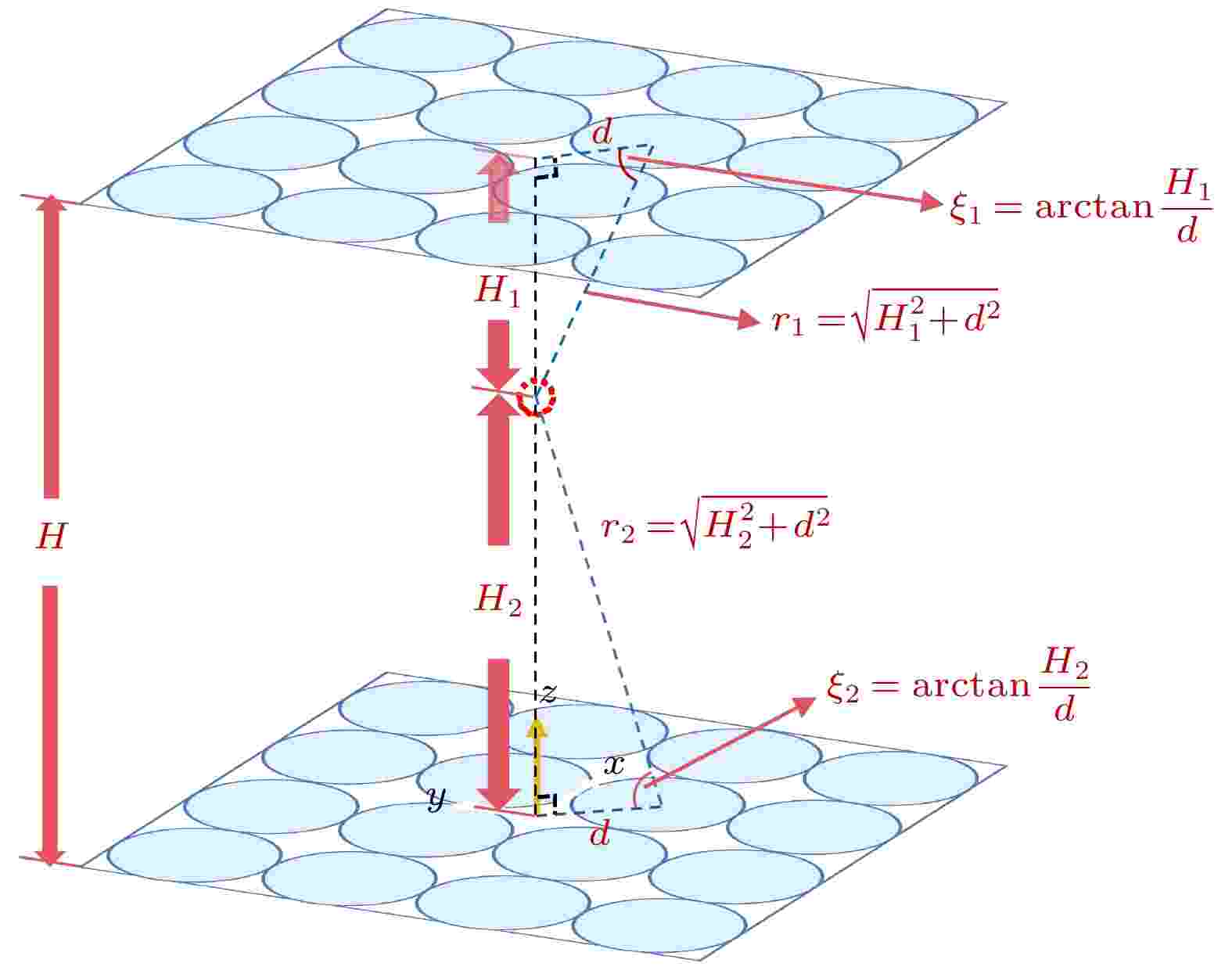
2021, 70 (21): 214302.
doi: 10.7498/aps.70.20210981
Abstract +
The acoustic radiation force allows acoustic tweezers to suspend and move tiny particles. The horizontal movement is one of the common forms in which acoustic tweezers manipulate particles. In this paper, the direct relationship between acoustic radiation force and sound pressure is derived theoretically. The results show that there is a corresponding relationship between the maximum point of sound pressure (focus point) and the minimum point of acoustic radiation force potential energy. A model for focused acoustic field in acoustic tweezers is established based on the principle of phase modulating. In the numerical simulation, taking the double-sided 16-element acoustic tweezers device for example, the method of controlling the horizontal movement of particles and its stability are analyzed. Owing to the influence of gravity, the balance in the vertical direction must be considered in the horizontal movement of particles. Horizontal movement shows different stabilities at different positions in acoustic filed. The closer to the center of the array the particle is, the more stably it moves. The step length (accuracy) also has an important influence on the moving stability. In general, the shorter the step size is, the higher the stability is. In this model, when moving step length is reduced by one-half, the stability is improved by nearly 40%. The research results have theoretical significance for designing acoustic tweezers, planning particle movement paths, and promoting the application of acoustic tweezers technology.

2021, 70 (21): 214303.
doi: 10.7498/aps.70.20210559
Abstract +
The dynamic behavior of coated microbubble in a magneto-acoustic field is very significant for its application to therapy. In this paper, the radial vibration equation of microbubble is derived by placing the coated-microbubbles in a tube filled with magnetic fluid and considering the magnetic pressure on the magnetic fluid under the magneto-acoustic field. The dynamic equation is nondimensionalized by using characteristic quantities such as Weber number and Reynolds number. The effects of magnetic-acoustic field parameters and magnetofluid characteristics on the vibration behavior of the vibration system are analyzed by the Runge-Kutta method. The results show that the magnetic field can prevent the collapse and make bubble oscillate stably. When the acoustic field is constant, the magnetic field can stabilize the oscillation of the microbubble and increase the equilibrium radius of the oscillating microbubble. The stronger the magnetic field is, the more obvious the influence of magnetofluid magnetisability χm on the vibration of the microbubble is and the stronger the nonlinear of the transient response of the microbubble is when the magnetic field is larger. In addition, the larger acoustic field parameters will enhance the response of oscillating microbubble to magnetic field. The larger the magnetic field is, the weaker the influence of acoustic parameters on the oscillations of microbubble is. Also, the transient response of microbubble is obviously nonlinear, but the steady-state response keeps the reciprocating oscillation with small amplitude. It can be seen that the adjusting of the magneto-acoustic field is beneficial to realizing the stable oscillation of microbubble in the blood vessel and avoiding collapse.

2021, 70 (21): 214304.
doi: 10.7498/aps.70.20211013
Abstract +
In this paper, a sound field model of elastically coupled normal mode suitable for complex eigenvalues is established. The normalization and coupling coefficient expression of elastic normal mode are given when the leaky mode is included. The coupling coefficients satisfy the conservation of sound energy flow. This model is used to analyze the coherent coupling characteristics of the normal mode of the sound field under the condition of the inclined elastic seabed. It is found that when the leaky mode is considered, the normal mode coupling will not only cause the amplitude of the normal mode to change, but also bring additional phase shift. The simulation calculation shows that under the condition of inclined elastic seabed, the acoustic propagation loss obtained by considering the effect of the additional phase shift of the leaky mode coupling is closer to the calculation result obtained by using the finite element commercial software, and that the mode coupling greatly enhances the amplitude of interface wave. In addition, this paper also analyzes the influence of changes in marine environmental parameters on sound transmission loss.

2021, 70 (21): 214305.
doi: 10.7498/aps.70.20210869
Abstract +
The cavitation effects occur in the ultrasound therapy technology. With the development of ultrasound therapy technology, cavitation effect in biological tissues has attracted more and more attention. The aim of the present study is to discuss the factors affecting cavitation nucleation and dynamics in tissues, and to provide a theoretical reference for the application of cavitation effects to ultrasound therapy. A model is developed for the cavitation inception in a spherical liquid cavity wrapped by an elastic medium. The Blake threshold value and the critical radius of the liquid cavity for the generation of spherical bubbles are obtained by the pressure equilibrium relationship. The effects of the excitation frequency, the volume modulus of the medium and the volume of the liquid in the cavity on the bubble vibration behavior are analyzed by deriving a bubble dynamic equation that consider the elastic effect of the medium outside the cavity using Lagrange equation. It is shown that the volume modulus, initial radius of bubble nucleus and surface tension can affect the Blake threshold pressure and bubble size, and those form a parameter reference for the control conditions that trigger or inhibit cavitation. The gas core can rapidly grow to a new equilibrium radius and oscillate under the action of an acoustic wave, and the bubble equilibrium radius is independent of the external field, but it can affect the bubble dynamic behavior. When the frequency of the ultrasonic signal is equal to the natural oscillation frequency of the bubble, the bubble collapses after several periods of intense vibration, and the pressure fluctuation in the liquid in the cavity is obvious. The response of bubbles under high frequency ultrasonic driving is relatively weak, and the oscillations of bubbles are dominated by free oscillation.

2021, 70 (21): 214401.
doi: 10.7498/aps.70.20210356
Abstract +
Electricity power has served as an essential source in our daily life. However, some remote areas that are difficult to be covered by the power grid, are still facing a serious shortage of electricity for outdoor equipment such as field monitors. Off-grid power is the alternative power in such areas, but there arise apparently economic and environmental problems. Therefore, the development of portable, pollution-free and sustainable power supply equipment has vital research significance. In this paper, based on the radiative cooling and greenhouse effects, a passive thermoelectric system without any active energy input is proposed. A square copper plate coated with a thin film of acrylic acid doped with SiO2 particles, with an average emissivity value of 0.937, is selected as a radiative cooling material. The commercial polyolefin film with a thickness of 0.12 mm is selected as a greenhouse material. The radiative cooling effect cools the cold end of the thermoelectric generator (TEG) during the nighttime, the greenhouse effect during the daytime is utilized to increase the temperature of the hot end of the TEG. The radiative cooling effect and the greenhouse effect both result in the increase of the temperature difference between the cold and hot ends, and thus obtaining the output power. During the period of time from June 17 to June 21, 2020, the performance of the designed system at the location of Shaanxi, China was evaluated experimentally, and the weather condition effects were also studied. The experimental results show that a stable temperature drop of ~1.1 ℃ of the cold end is achieved via the radiative cooling effect at night. Owing to the greenhouse effect, the temperature increase of the hot end reaches a maximum value of 13.9 ℃. When the average ambient humidity decreases from 45% to 20%, the average temperature difference between the hot end and cold end of the thermoelectric module increased from 1.6 to 1.9 ℃ throughout the day, and the average power increased from 47.8 to 67.3 mW/m2, indicating that the equipment can have better power generation performance under the condition of 20% ambient humidity. The device developed in this work realizes all-day passive output and shows that it has potential applications in off-grid power supplies.
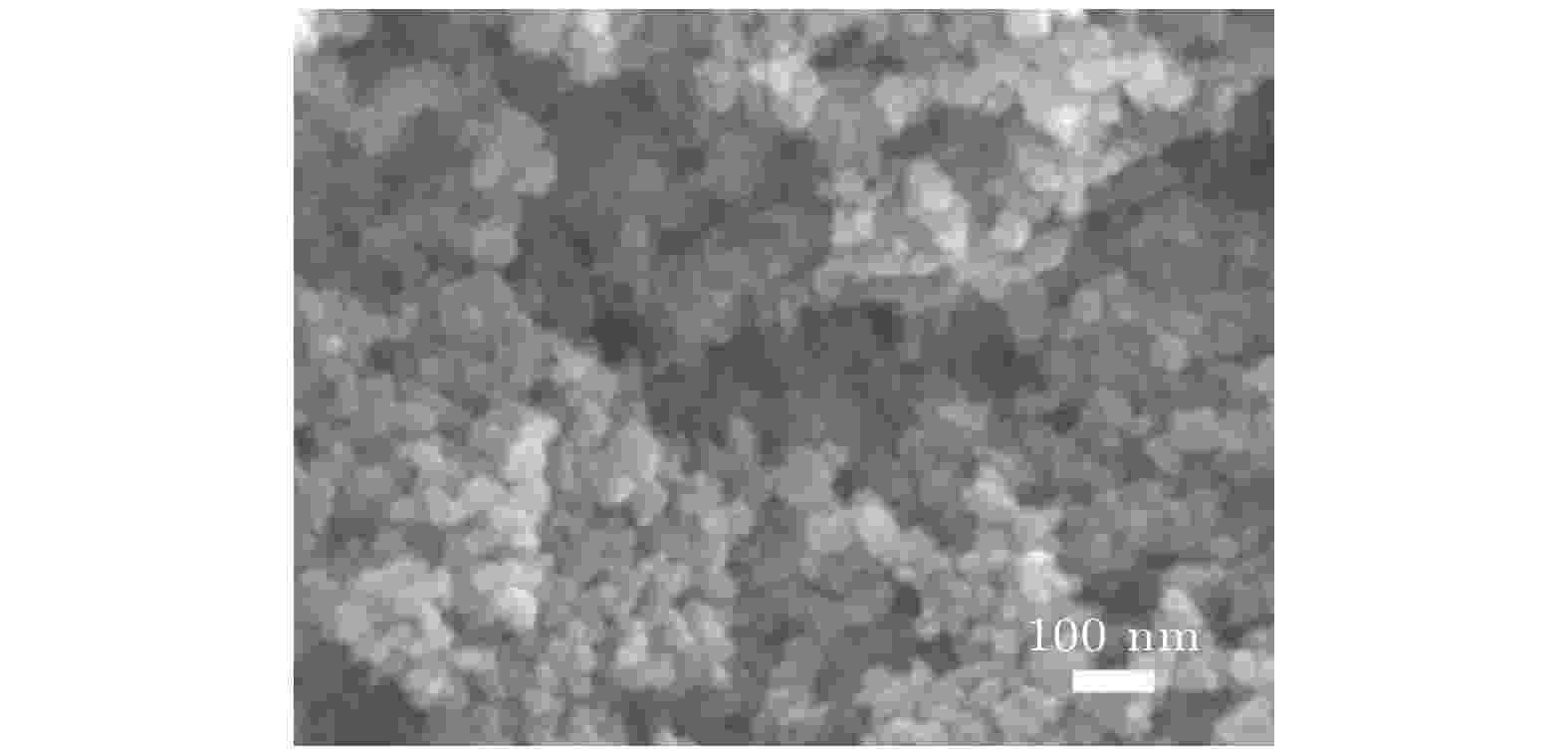
EDITOR'S SUGGESTION
2021, 70 (21): 214601.
doi: 10.7498/aps.70.20210210
Abstract +
The friction between some nanomaterials and teflon magnetic stirring rods has recently been found responsible for dye degradation by magnetic stirring in dark. In this work, a study is conducted on the reduction of CO2 by TiO2 nanoparticles under magnetic stirring in water. In a 100-mL reactor filled with 50-mL water, 1.00-g TiO2 nanoparticles and 1-atm CO2, 50-h magnetic stirring results in the formation of 6.65 × 10–6 (volume fraction) CO, 2.39 × 10–6 CH4 and 0.69 × 10–6 H2; while in a reactor without TiO2 nanoparticles, the same magnetic stirring leads only 2.22 × 10–6 CO and 0.98 × 10–6 CH4 to form. Four magnetic stirring rods are used simultaneously to further enhance the stirring, and 50-h magnetic stirring can form 19.94 × 10–6 CO, 2.33 × 10–6 CH4, and 2.06 × 10–6 H2. A mechanism for the catalytic role of TiO2 nanoparticles in the reduction of CO2 and H2O is established, which is based on the excitation of electron-hole pairs in TiO2 by mechanical energy absorbed through friction. This finding clearly demonstrates that nanostructured semiconductors are able to utilize mechanical energy obtained through friction to reduce CO2, thus providing a new direction for developing and utilizing the mechanical energy harvested from ambient environment.
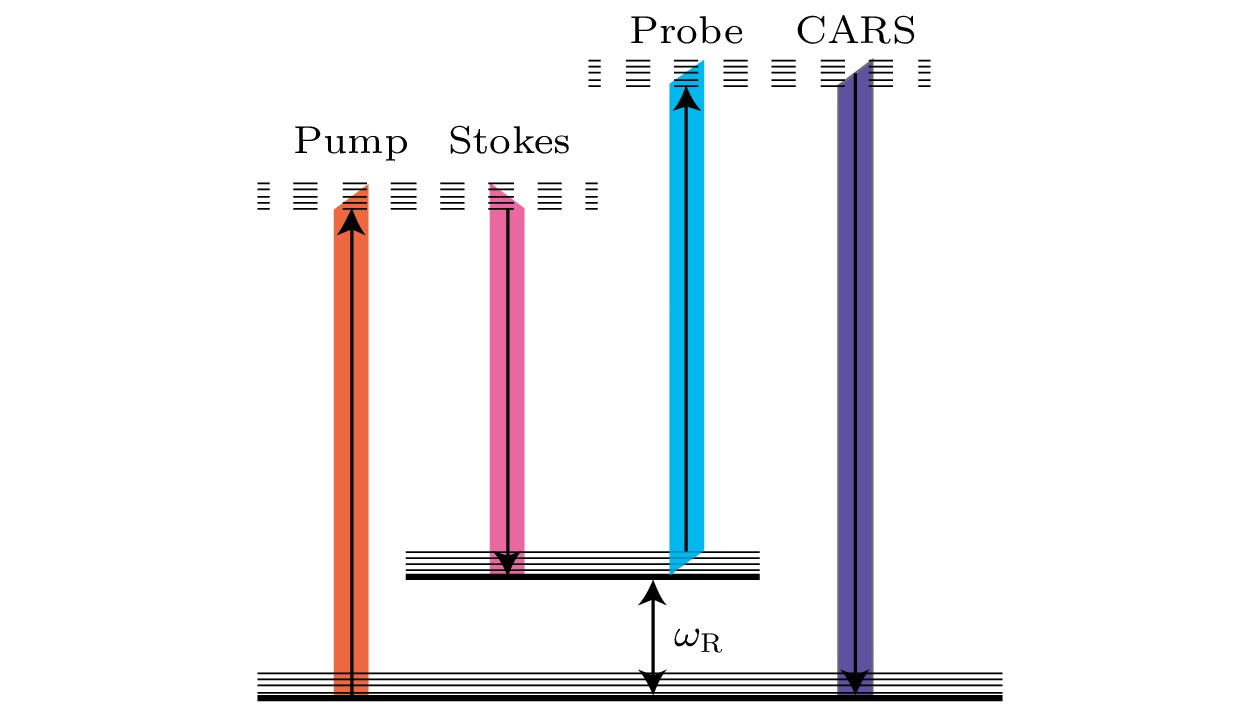
EDITOR'S SUGGESTION
2021, 70 (21): 214203.
doi: 10.7498/aps.70.20211144
Abstract +
Temperature, as an important parameter in combustion diagnostic process, will directly affect the combustion efficiency and the generation of combustion products. The accurate measuring of combustion temperature and then controlling of combustion state can not only contribute to avoiding the generation of harmful waste gas, such as carbon monoxide (CO) and oxynitride (NOx), but also improve the combustion efficiency, thereby saving the energy. However, in practical applications, dynamic and high-temperature combustion field has strict requirements for measurement accuracy and response speed of the thermometry technology. As an advanced spectral thermometry technology, coherent anti-Stokes Raman scattering (CARS) has a much higher spatial resolution, and can achieve accurate temperature measurement in high-temperature environment, so CARS has the potential applications in complex combustion field. For the temperature measurement requirements in the complex dynamic and high-temperature combustion field, we demonstrate a hybrid femtosecond/picosecond coherent anti-Stokes Raman scattering thermometry method through using the second harmonic bandwidth compression method, and achieve accurate measurements and dynamic response to temperature in dynamic and high-temperature combustion field. By using the narrow-band picosecond pulse obtained from the sum frequency process of femtosecond pulse in the BBO crystal as a probe pulse, this thermometry method can achieve single-shot, 1-kHz temperature measurement in high-temperature flame. We utilize the standard burner to simulate dynamic combustion field in a range of 1700–2200 K by changing the equivalence ratio quickly, and carry out continuous temperature measurement in 70 s by our thermometry method in this simulated dynamic and high-temperature flame. The least square method is used to fit the theoretical spectrum library to the actual single spectrum, and the fitting temperature corresponding to the actual single spectrum is obtained from the curve of fitting error. The continuous temperature measurements in 70 s exhibit superior performance in dynamic and high-temperature flame with a temperature inaccuracy less than 1.2% and a precision less than 1.8% at four different temperatures, and can track the temperature variation process within 0.2 s dynamically. These results verify the accuracy, stability and response speed in dynamic and high-temperature environment, and provide a new system scheme for thermometry in practical harsh combustion field.
PHYSICS OF GASES, PLASMAS, AND ELECTRIC DISCHARGES
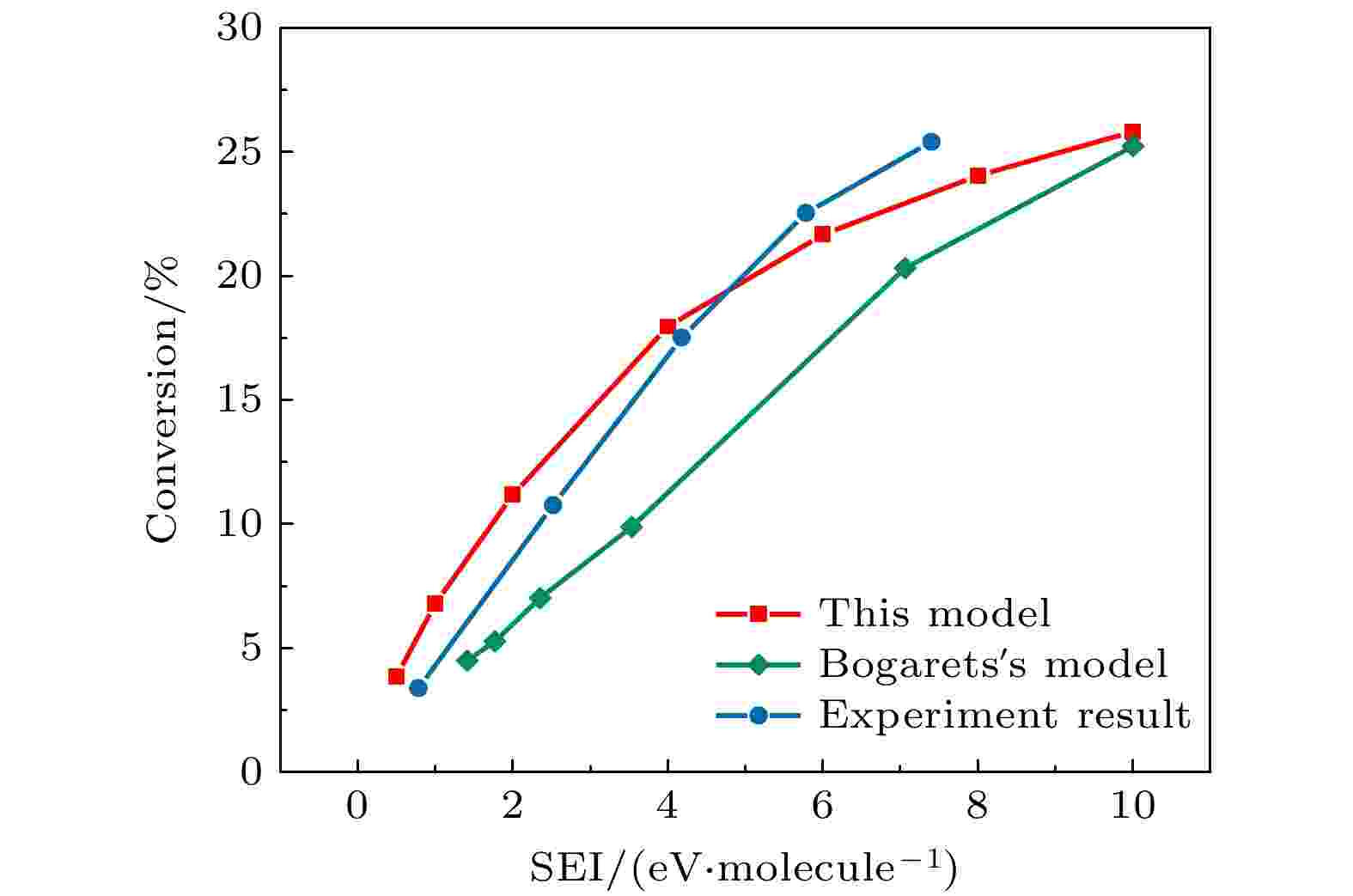
2021, 70 (21): 215201.
doi: 10.7498/aps.70.20210664
Abstract +
The exploration of Mars has attracted increasing interest in these years. The experiments and simulations show that strong electric field triggered by the dust storms in the Martian atmosphere may cause CO2 discharge. Studies on this phenomenon will not only help deepen our comprehension on the evolution of Martian surface, but also provide a possibility to realize the in-situ oxygen generation on Mars based on plasma chemistry. In this paper, a zero-dimensional global model is used to simplify the complicated description of CO2 chemical kinetics, therefore a reduced chemistry can be obtained for detailed numerical simulation in the near future. At the beginning of simplification, the graph theoretical analysis is used to pre-treat the original model by exploring the relationship between reacting species. Through the study of connectivity and the topological network, species such as O2, e, and CO prove to be important in the information transmission of the network. While gaining a clearer understanding of the chemistry model, dependence analysis will be used to investigate numerical simulation results. In this way a directed relation diagram can be obtained, where the influence between different species is quantitively explained in terms of numerical solutions. Users could keep different types of species correspondingly according to their own needs, and in this paper, some species with low activeness such as C2O, $ {\mathrm{O}}_{5}^{+} $ , $ {\mathrm{O}}_{4}^{-} $ and species with uncertainties such as $ {\mathrm{C}}_{2}{\mathrm{O}}_{2}^{+} $ , $ {\mathrm{C}\mathrm{O}}_{4}^{+} $ are removed from the original model. As for the reduction of specific reactions among species, the reaction proportion analysis based on the calculation of reaction rates is used to obtain the contribution of each reaction to the entire process of CO2 discharge, through which the important reactions can be selected. Finally, a simplified chemistry model of CO2 discharge based on Martian atmospheric conditions, including 16 species and 67 reactions, is established. The numerical simulations show that the trends of species densities based on the simplified chemistry model are highly consistent with those based on the original one, and considerations about the CO2 conversion and the energy efficiency are also in line with expectations, which can help deepen the understanding of the essential process of CO2 discharge under Martian atmospheric conditions. In addition, the quantitative results of the relationship between reactive species will lay a theoretical foundation for the accurate analysis of various products in Martian dust storm discharges and the realization of Mars in-situ oxygen generation technology based on plasma chemistry.
CONDENSED MATTER: STRUCTURAL, MECHANICAL, AND THERMAL PROPERTIES

2021, 70 (21): 216101.
doi: 10.7498/aps.70.20210244
Abstract +
The thermal-mechanical properties of transition metal carbonitrides can be affected by the concentration and ordering of vacancies besides the C/N atomic ratio. However, there are few reports on the vacancy ordered structure of ternary transition metal carbonitrides. In the present paper, the first-principles method is used to study the vacancy ordered structures, mechanical properties, electronic properties and the effect of vacancies on the ternary Hf-C-N system. Firstly, the crystal structures of Hf-C-N system is examined by the first-principles and evolutionary algorithms implemented in USPEX under ambient pressure, and eight thermodynamical stable vacancy ordered structures are found, each of which has a rock-salt structure, and is also dynamical and mechanical stable, which are verified by the calculations of their phonon dispersion curves and elastic constants. The vacancies are occupied at the [Hf6] octahedral interstices, which replace the positions of non-metal atoms. Their crystallographic data such as space group, lattice constants are also predicted. To the best of our knowledge, there is no report on the Hf-C-N vacancy ordered structures and these structures investigated here in this work are all found for the first time. Then their mechanical properties are calculated. The Hf-C-N vacancy ordered structures all have very high bulk, shear and elastic modulus and hardness. It is found that except for C∶N = 1∶4, for the Hf-C-N system with the same C/N ratio the moduli, Vickers hardness values, and Pugh’s ratios decrease with the increase of the concentration of vacancy. However, the Vickers hardness of Hf6CN4 (the concentration of vacancy is equal to 1/6) is higher than that of Hf5CN4 (no vacancy), that is so-called vacancy hardening. Finally, the electronic density of states and the crystal orbital Hamilton populations are calculated. The chemical bonding of Hf-C-N vacancy ordered structure is analyzed, which is a mixture of covalence and metallic and is similar to that of binary transition metal carbides and nitrides. With the increase of the concentration of vacancy, the total bond strength decreases, and then the modulus decreases for Hf-C-N compound.

2021, 70 (21): 216301.
doi: 10.7498/aps.70.20210812
Abstract +
In this paper, a model of Si atom adsorbed on black phosphorene with a coverage of 2.778% is constructed and the electronic properties of the model are calculated based on density functional theory. Moreover, the electronic properties are regulated by stress and electric field. Under the coverage of the current research, the results show that the adsorption of Si atoms results in the destruction of the black phosphorene’s geometric symmetry, which intensifies the charge transfer in the system and completes the orbital re-hybrid. The band gap of black phosphorene thus disappears and the transition from semiconductor to quasi metal is completed. The stable adsorption is at the H site in the middle of the P atomic ring. Both tensile field and electric field reduce the stability of the system. Owing to the tensile deformation, the band gap is opened by the structure of Si atom adsorbed on black phosphorene. And since the band gap is proportional to the deformation variable, it can be regulated and controlled. Under the combined action of electric field and tensile, the introduction of the electric field leads the band gap of Si adsorbed on black phosphorene system to be narrowed and the transition from the direct band gap to an indirect one to be completed. The band gap still goes up in proportion to the increase of deformation. The band gap of Si atom adsorbed on black phosphorene system is more adjustable than that of the Si atom that is not adsorbed on black phosphorene system, and the stable adjustment of the band gap is more likely to be realized.
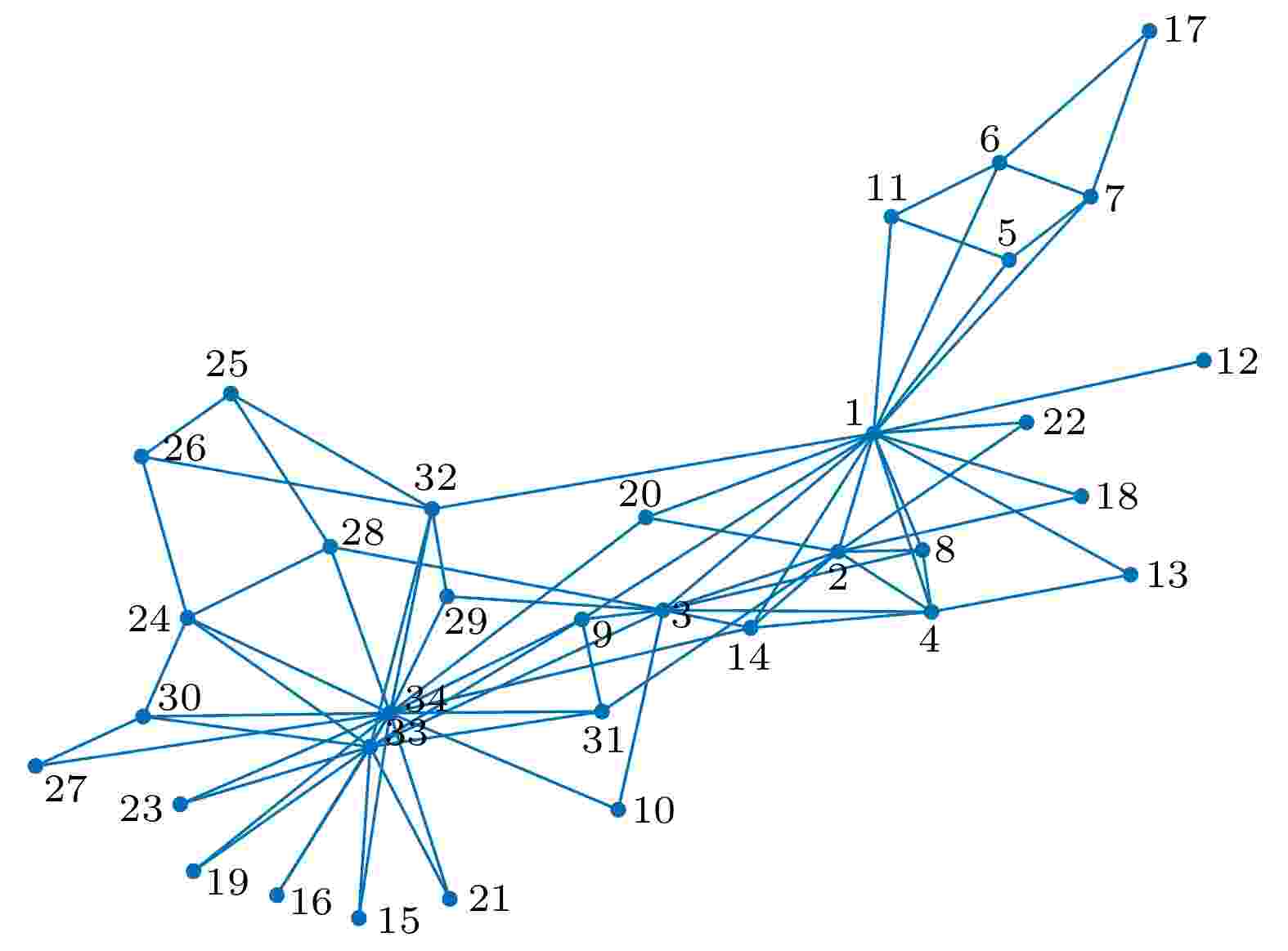
2021, 70 (21): 216401.
doi: 10.7498/aps.70.20210979
Abstract +
Evaluating the importance of nodes in complex networks is an important topic in the research of network characteristics. Its relevant research has a wide range of applications, such as network supervision and rumor control. At present, many methods have been proposed to evaluate the importance of nodes in complex networks, but most of them have the deficiency of one-sided evaluation or too high time complexity. In order to break through the limitations of existing methods, in this paper a novel method of evaluating the importance of complex network nodes is proposed based on Tsallis entropy. This method takes into account both the local and global topological information of the node. It considers the structural hole characteristics and K-shell centrality of the node and fully takes into account the influence of the node itself and its neighboring nodes. To illustrate the effectiveness and applicability of this method, eight real networks are selected from different fields and five existing methods of evaluating node importance are used as comparison methods. On this basis, the monotonicity index, SIR (susceptible-infectious-recovered) model, and Kendall correlation coefficient are used to illustrate the superiority of this method and the relationship among different methods. Experimental results show that this method can effectively and accurately evaluate the importance of nodes in complex networks, distinguish the importance of different nodes significantly, and can show good accuracy of evaluating the node importance under different proportions of nodes. In addition, the time complexity of this method is $ O({n^2}) $ , which is suitable for large-scale complex networks.
CONDENSED MATTER: ELECTRONIC STRUCTURE, ELECTRICAL, MAGNETIC, AND OPTICAL PROPERTIES
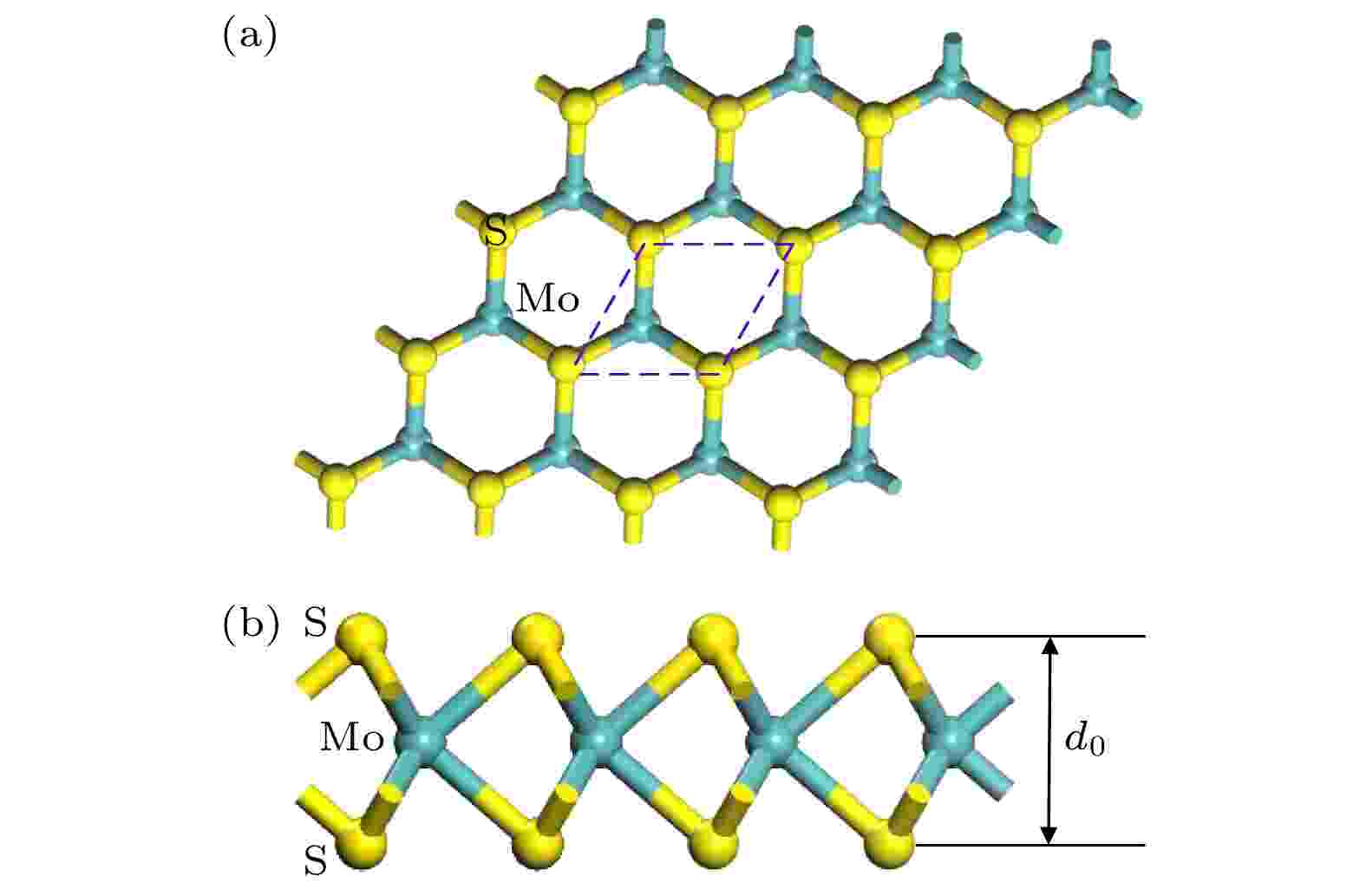
2021, 70 (21): 217101.
doi: 10.7498/aps.70.20210816
Abstract +
Monolayer molybdenum disulfide is an ideal material for making various micro/nano components and flexible electronic devices. However, the strain of material caused by the environment is a key problem that cannot be avoided in practical applications, and the electronic structure of material will also change with the strain. In this paper, the effect of tensile strain on the photoelectric properties of monolayer MoS2 is studied based on first principles and tensile tests after wet transfer. The results are obtained as follows. 1) Intrinsic monolayer MoS2 is a direct bandgap semiconductor with a band gap of 1.68 eV, the highest peak of the absorption coefficient curve is nearly 10.92 eV, and a maximum absorption coefficient is 1.66 × 105 cm–1. 2) A small tensile strain (1%) will result in the transition from direct to indirect gap for monolayer MoS2. With the increase of strain, the feature of the indirect gap can be preserved but the gap decreases linearly. The gap will decrease to 0 eV when the tensile strain is 10%, and the absorption coefficient curve is red-shifted as a whole with strain. 3) The in-plane mode peak and the out-of-plane mode A1g peak in Raman spectra are re-dshifted with stretching by tensile test of wet-transferred monolayer MoS2, and the difference in peak frequency between the two peaks is maintained at about 18.6 cm–1. The strong emission peak of an exciton of monolayer MoS2 is observed at 1.83 eV of the photoluminescenc spectrum. With the increase of tensile strain, the relative strength of the peak decreases and is linearly re-dshifted, which means that the band gap decreases linearly. It is consistent with the theoretical calculation result.
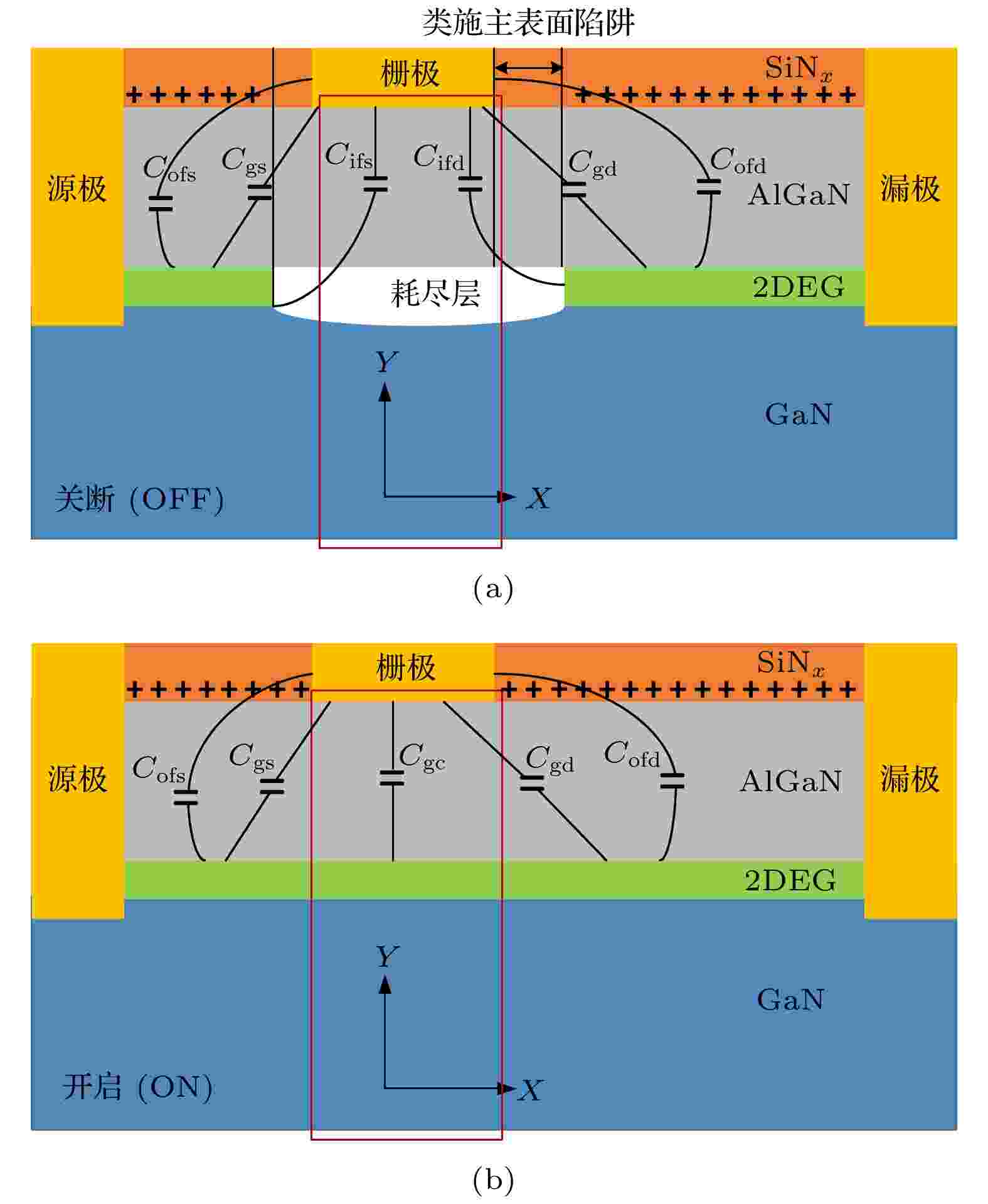
2021, 70 (21): 217301.
doi: 10.7498/aps.70.20210700
Abstract +
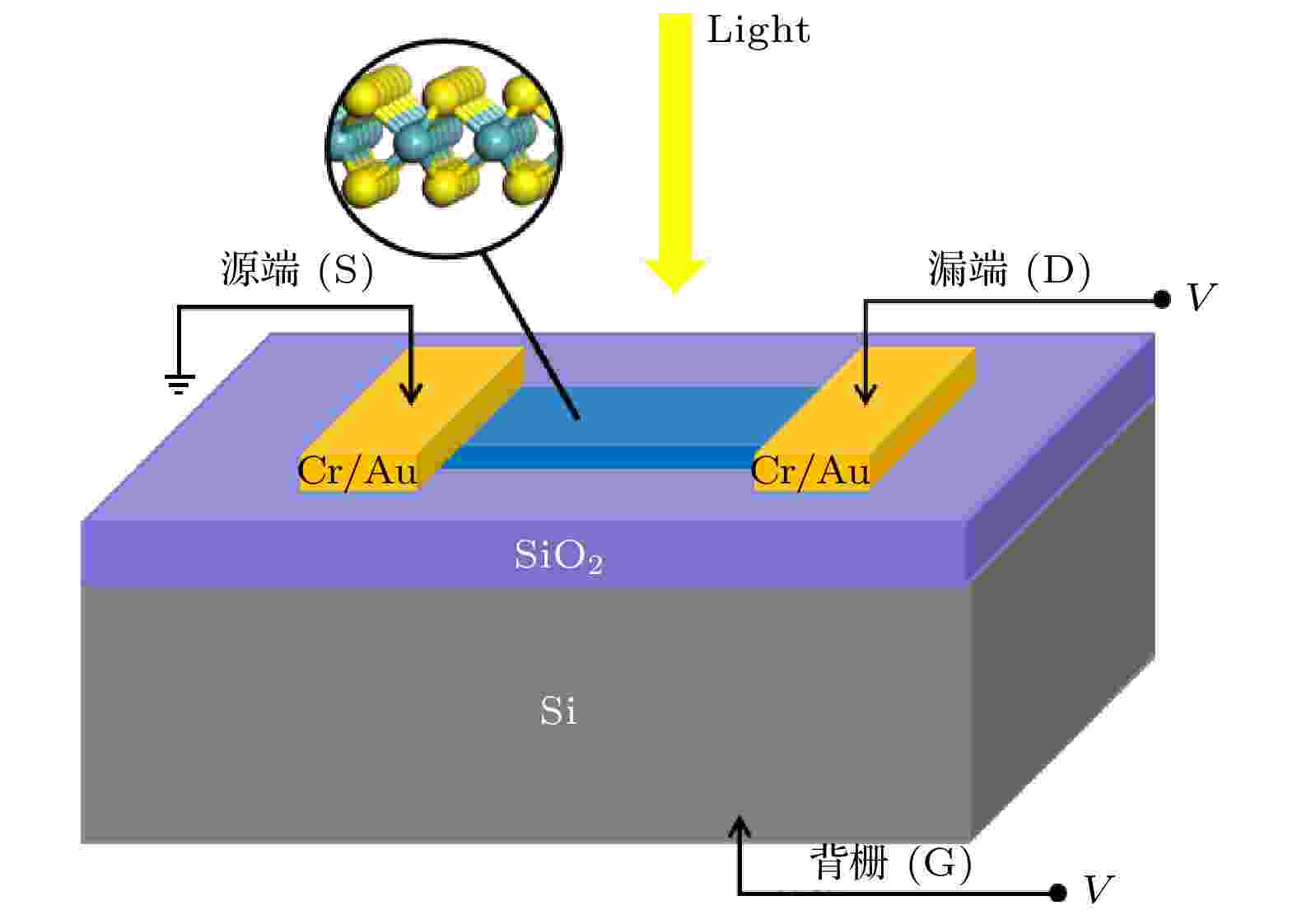
EDITOR'S SUGGESTION
2021, 70 (21): 217302.
doi: 10.7498/aps.70.20210750
Abstract +
Memtransistor is a new multi-terminal device which combines the properties of memristor and field effect transistor and simultaneously realizes information storage and processing. In this paper, the multilayer MoS2 is prepared by micromechanical exploration method, then the back gate MoS2 memtransistor with field effect transistor structure is fabricated, and the resistive switching characteristics and mechanism of the device under electric field, light field and their synergistic regulation are systematically studied. The experimental results show that the multilayer MoS2 memtransistor has excellent bipolar resistance behavior and good cycle durability. Under the control of gate voltage, the switching ratio of the device can be tuned in a range of 100-105, up to 1.56 × 105, which indicates that the device has a strong gating effect. Under the control of light illumination, the resistance characteristics of the device are strongly dependent on the incident wavelength. When photoelectric synergistic regulation is performed, the device displays excellent four-terminal control capability, and the switching ratio is enhanced up to 4.8 × 104. The mechanism of resistive switching characteristics can be attributed to the changes of charge capture state and Schottky barrier height at the interface between MoS2 and metal electrodes, and the continuous photoconductance effect caused by photogenerated carriers in MoS2 channel.
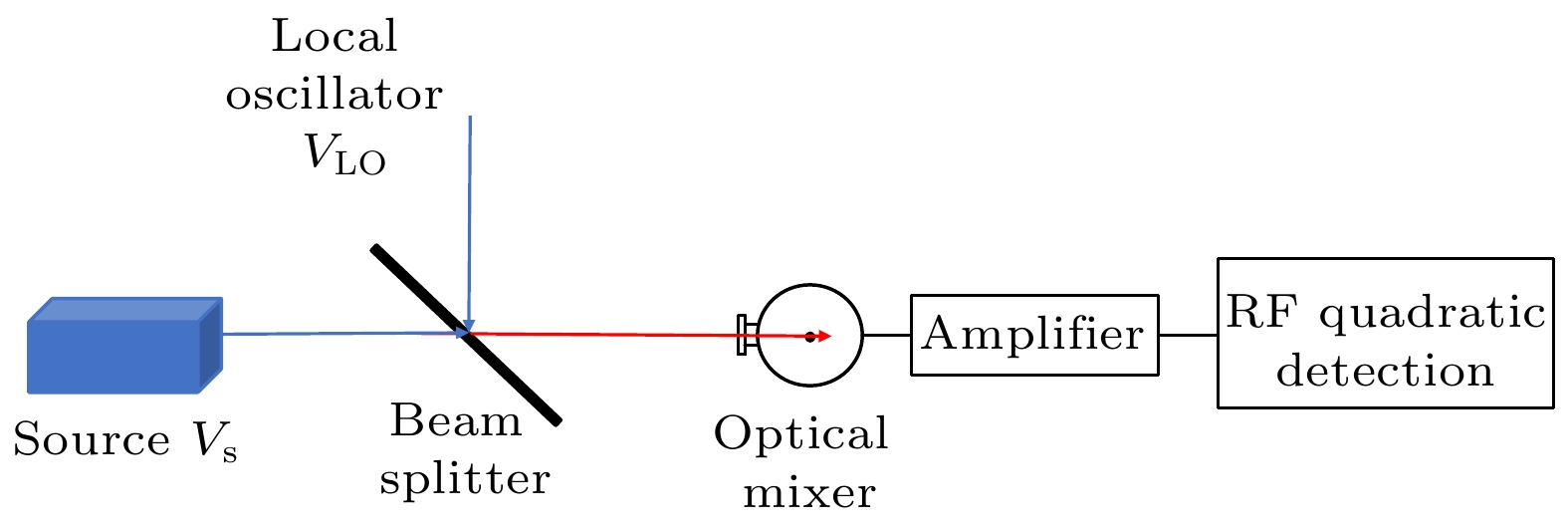
2021, 70 (21): 217801.
doi: 10.7498/aps.70.20210710
Abstract +
aser heterodyne spectroscopy detection has rapidly developed in recent years due to its high spectral resolution, small size, and light weight. It can be used to measure the atmospheric greenhouse gas vertical profile and calibrate the carbon satellite ground. This paper reports a laser heterodyne system for measuring atmospheric N2O, with a 3.939-µm interband cascade laser used as a local oscillator light source. A homemade high-precision solar tracker collects sunlight as a laser heterodyne signal source. The tracking accuracy reaches 7 arcsec, and the spectral resolution of the laser heterodyne system arrives at 0.004 cm–1. The atmospheric N2O absorption spectrum in Hefei area (31.902°N, 117.167°E) is measured, and two strong absorption peaks respectively at 288.336 and 2539.344 cm–1 are obtained. In addition, the wavelength calibration of the absorption signal, and the entire atmospheric transmittance spectrum of N2O molecules are obtained, and the signal-to-noise ratio is 93. The high-resolution spectrum data are normalized and frequency is corrected, and the N2O atmospheric concentration profile is obtained by using the reference forward model and the optimal estimation algorithm. The standard deviation of volume fraction is in a range of 0.000031—0.0026 ppm, and the corresponding relative error range is 0.009%—0.83%. The research results show that the laser heterodyne system built in this work can be used to measure the absorption spectrum of N2O in the atmosphere and realize the inversion of the N2O profile, which provides a guarantee for long-term observation of atmospheric N2O concentration.
INTERDISCIPLINARY PHYSICS AND RELATED AREAS OF SCIENCE AND TECHNOLOGY

2021, 70 (21): 218101.
doi: 10.7498/aps.70.20210752
Abstract +
The glass transition temperature and nonlinear mechanics of polymer nanocomposites are strongly influenced by the short fibers. In this paper, coarse-grained molecular dynamics simulations are used to study the effects of single-walled carbon nanotube (CNT) content on the glass transition, diffusion coefficient, viscosity and nonlinear mechanical properties of poly(methyl methacrylate) (PMMA)/CNT nanocomposites. The glass transition temperature Tg is very important for the application of the materials. The Tg is related to the specific volume of the system. Generally, the location of the discontinuity on the curve of specific volume vs. temperature is the position of Tg. Our simulation results show that the Tg of PMMA/CNT composite increases with CNT content, and the result is consistent with the experimental value (434 K). This increase of Tg is evidently due to the presence of CNTs, which imposes a limit on the mobility of the molecules of PMMA. For the free volume in the liquid state, recent experiments pointed out that the molecular mutation is relatively easy to occur because the unoccupied volume is large. Further analysis of the diffusion coefficient of the PMMA/CNT indicates that the difference in diffusion characteristic occurs above the glass transition temperature, and the diffusion coefficient of PMMA system and PMMA/CNT system are the same below the glass transition temperature. Polymer materials in the service process will inevitably suffer the deformation, and the modulus and toughness of material are inversely proportional. Based on this problem, the nonlinear mechanical properties of short CNTs added PMMA composite are studied by nonequilibrium molecular dynamics. Our results show that the yield modulus increases with the CNT content increasing. However, the toughness is almost unchanged. In order to further understand the origin of stress of PMMA/CNT nanocomposites, the stretch ratio and orientation parameters of MPPA chains are also investigated in the present work. According to the stretch ratio and orientation parameters, it is not difficult to conclude that the stress-strain curve is mainly the result of the synergistic effect of molecular chain stretching and orientation. This work provides a theoretical guidance for further experiments and processing at the atomic and molecular level.
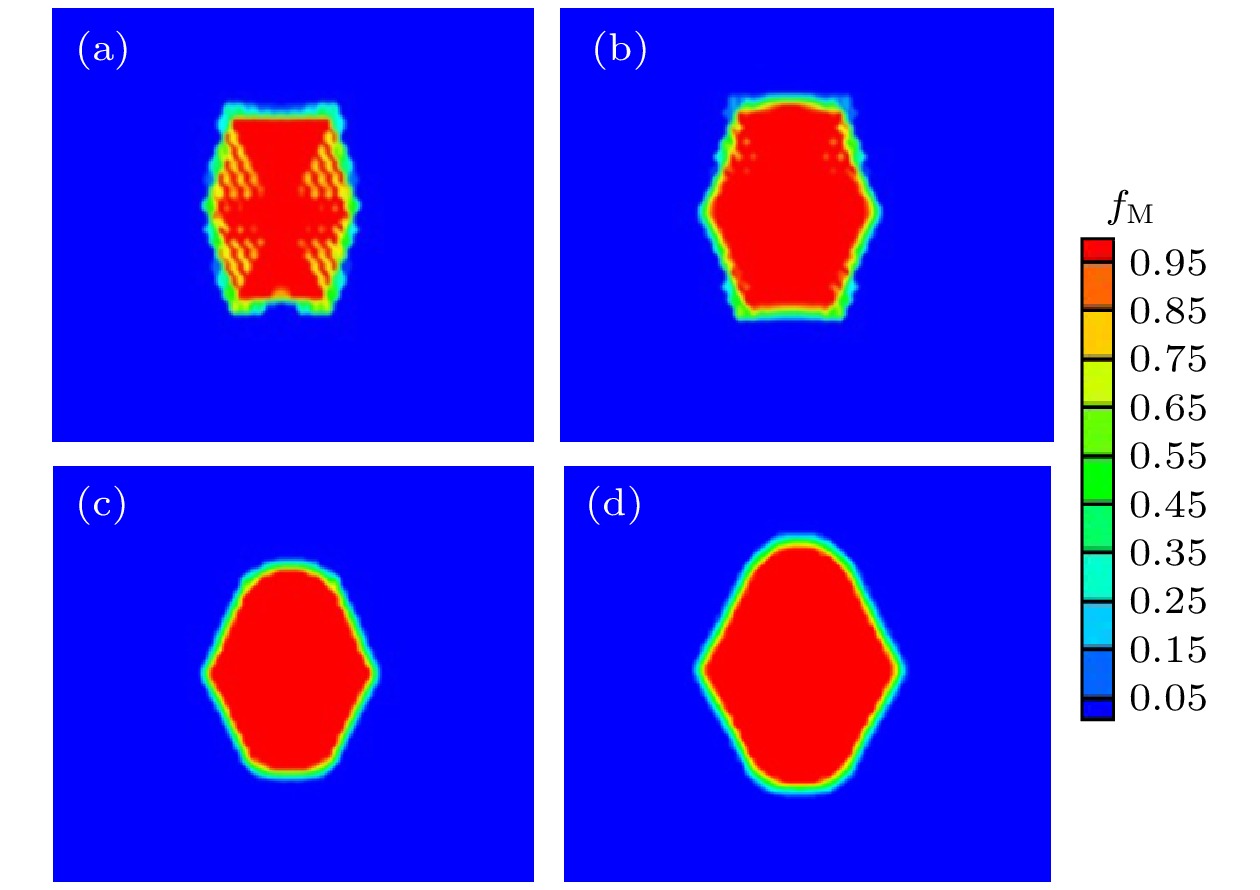
2021, 70 (21): 218102.
doi: 10.7498/aps.70.20210725
Abstract +
M7C3 carbide’s amount, size, morphology and distribution in the microstructure contribute much to the wear resistance of high chromium cast irons. In the present paper, a two-dimensional microscopic cellular automaton model for the growth of the faceted M7C3 carbide together with the austenitic dendrite grains in an Fe-4%C-17%Cr ternary alloy is developed to obtain the evolution of M7C3 carbide grain morphology, the concentration redistribution and their interaction during the growth of M7C3 carbide and austenite grains, and also the total influence on the final M7C3 carbides’ size. The model includes the effect of latent heat release on the temperature drop. The grain growth velocity is determined by both the diffusion of C solute and the diffusion of Cr solute at the S/L interface. The equilibrium concentration in liquid cells is interpolated from the tablulated solidification path which is prescribed by Gulliver-Scheil approximation coupling with the thermodynamic equilibrium calculation. The morphology of the faceted M7C3 carbide is maintained through setting its neighborhood relations and optimizing its shape factor at grain growth. The results show that the individual grain growth velocity for M7C3 carbide and austenite increases with the increase of the supersaturation and Peclet number of solute C and Cr. The austenite precipitation and grain growth obviously speed up the growth velocity of M7C3 carbide grains. While with the austenite grains gradually touching and enveloping the M7C3 carbide grain, the growth velocities for both kinds of grains decrease. The rejection of solute C and Cr during austenite grain growth complements the absorption of solute C and Cr during M7C3 carbide grain growth, thus promoting their growth. The predicted cooling curve fits with the evolution tendency of the experimental one. The predicted final solidification microstructure and M7C3 carbide amount in volume fraction are in agreement with the experimental ones. Furthermore, both C solute concentration distribution and Cr solute concentration distribution in both residual liquid and austenite are consistent with the predictions by the Gulliver-Scheil, partial equilibrium and lever rule model.
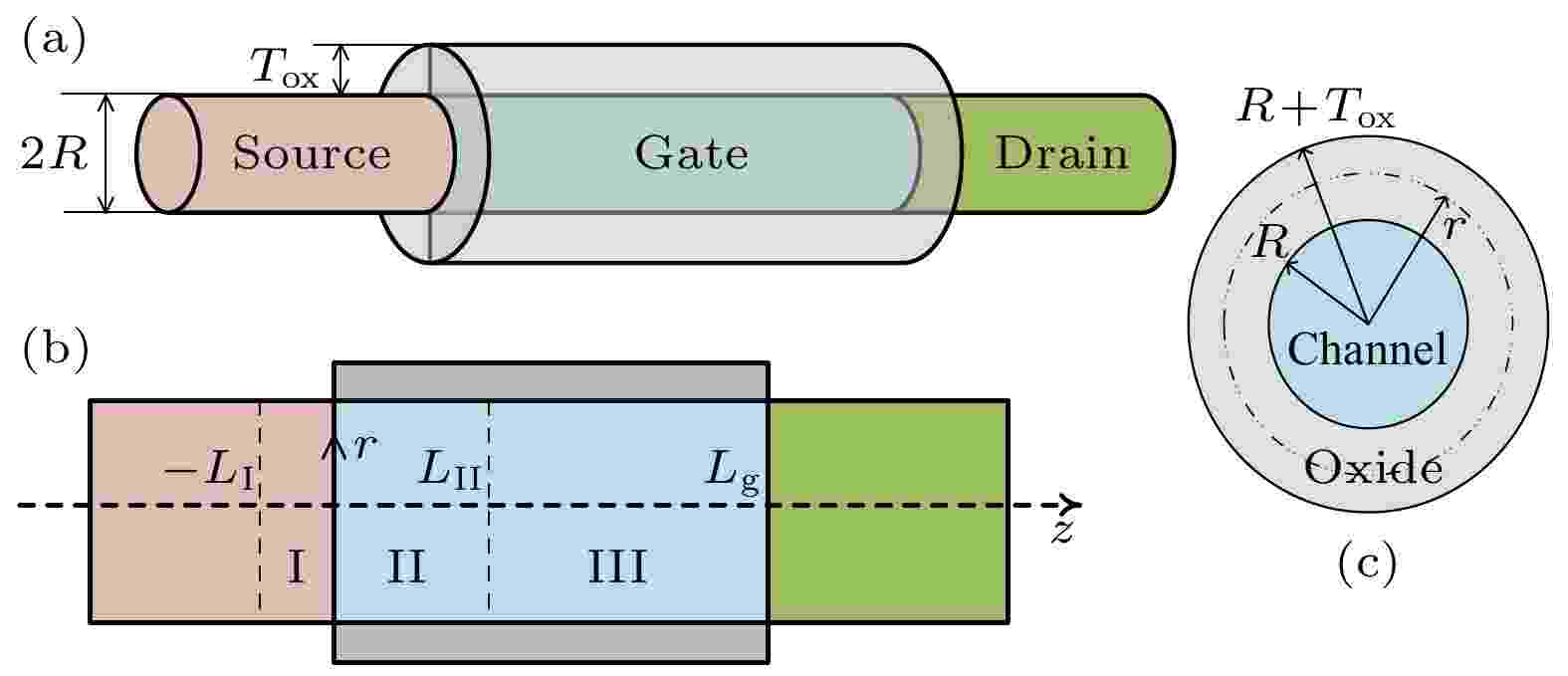
2021, 70 (21): 218501.
doi: 10.7498/aps.70.20211128
Abstract +
The nanowire gate-all-around (GAA) structures with the nearly ultimate channel electrostatic integrity of the gate field can exhibit the best immunity to the short channel effect and drain-induced barrier lowering. Moreover, owing to the enhanced control efficiency of gate over the tunneling junction, the GAA-TFET also gives improved subthreshold swing and on-state current. Despite the excellent device performance, an accurate model is very significant for the practical application. Compared with the numerical methods which are usually time consuming and computationally inefficient, an analytical model could accelerate the device investigation and circuit design process. Even though some tunneling current models have already been reported for nanowire tunneling field-effect-transistors (TFETs), the model of the terminal capacitance is still an issue for nanowire TFETs. The capacitance is of great significance for the transient simulation. In this paper, a physical and analytical potential model considering both the source depletion region and the channel mobile charges, is developed for the GAA-TFETs. The results from the model are verified with the numerical simulations, and the excellent agreement between the two results indicates the validation of the proposed model. Based on the potential model, the terminal charge model and the capacitance model are further developed and also verified by the numerical simulations. The main inflection and variation of the terminal charges and capacitances with the biases can be predicted by our model. Besides, both the model results and the numerical simulations both demonstrate that the gate charge is dominated mainly by the drain charges and the contribution of the source charges can be almost neglected. This also leads to the very small gate-source capacitance and very large Miller capacitance in the TFET device. This will be detrimental to the performance of TFET-based digital circuits but can be mitigated with the hetero-oxide gate structure. The second order effects, such as the quantum confinement and traps, are ignored in this paper and can be taken into the core model in the future work. It should also be noted that there is no iterative process involved during the model derivation, thus the developed model can be easily applied to the widely used SPICE platform and will be useful in designing and investigating the GAA-TFET based circuits.
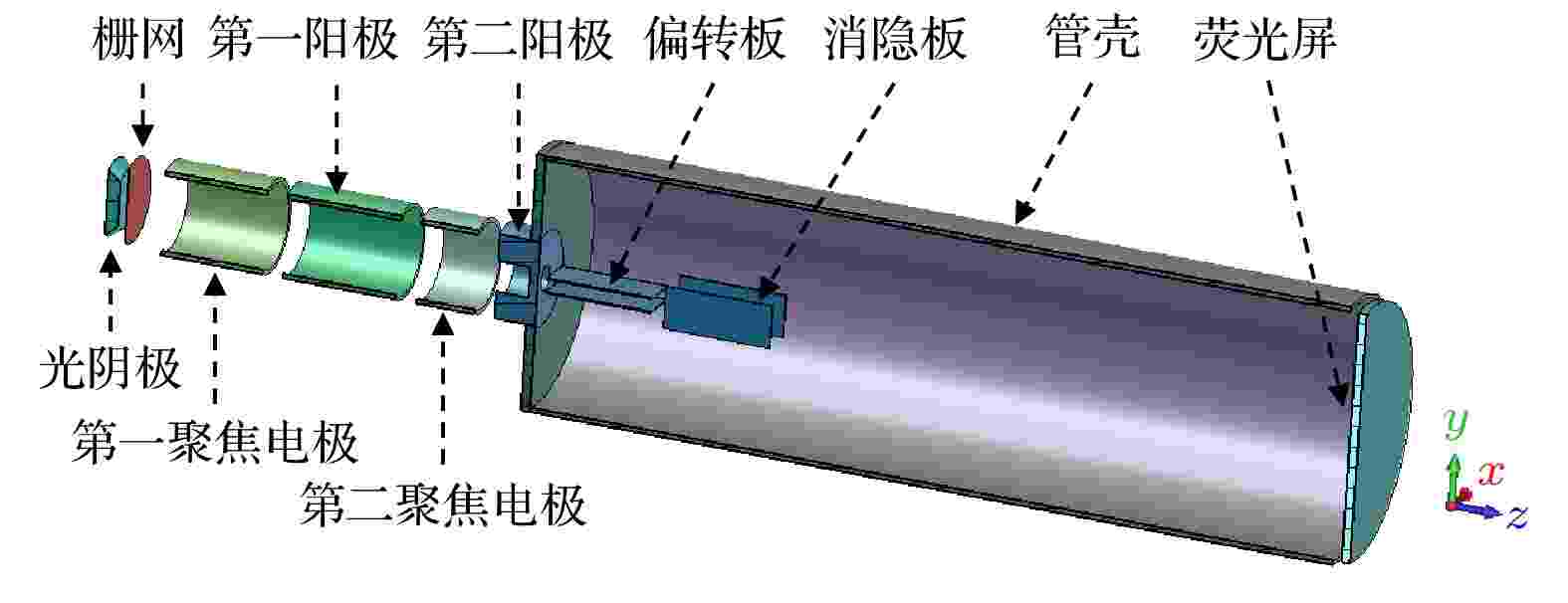
2021, 70 (21): 218502.
doi: 10.7498/aps.70.20210814
Abstract +
A synchroscan streak tube with high spatiotemporal resolution and high deflection sensitivity is proposed, which contains several innovation designs. Some measures are taken to improve the imaging performances of the streak tube. Firstly, in order to obtain a high deflection sensitivity, the difference in voltage between the photocathode and anode and the length of the equipotential region of the streak tube are reduced as much as possible. Secondly, by introducing a hyperfine grid behind the cathode, reasonably designing the voltages applied to the six-electrode electrostatic focusing system, and moving the electron beam crossing point to the entrance of the deflection plates, the temporal dispersion and the temporal distortion of the streak tube are reduced, and the spatiotemporal resolution of the streak tube is improved. Besides, the streak tube is technically analyzed by tracking the temporal and spatial distribution of electrons under an operating voltage of 7000 V with the aid of computer simulation technology (CST) software. The results show that the deflection sensitivity is 125 mm/kV, the physical temporal resolution is better than 1.83 ps @MTF = 10%, and the static spatial resolution on the photocathode is better than 38 lp/mm @MTF = 10% over the effective photocathode area with a size of 10 mm × 4 mm. By applying a synchronous scanning voltage with a repetition frequency of 250 MHz to the deflection electrode, the results show that the dynamic spatial resolution of the streak tube is better than 16 lp/mm, the limit of the dynamic temporal resolution is 1.39 ps, and two rectangular electron pulses with a size of 10 mm × 20 μm and an interval of 2.3 ps emitted from the photocathode can be well resolved by the streak tube. In addition, the experimental measurements are conducted with a streak tube developed in our laboratory. The results demonstrate that the photocathode of the streak tube can work in the entire visible light region, and the response in the short wavelength region is significantly better than that in the long wavelength region. The static spatial resolution of this streak tube is 40 lp/mm in the center of the photocathode. The temporal resolution of this streak tube is 5.55 ps measured under a synchronous scanning voltage with a repetition frequency of 75 MHz.
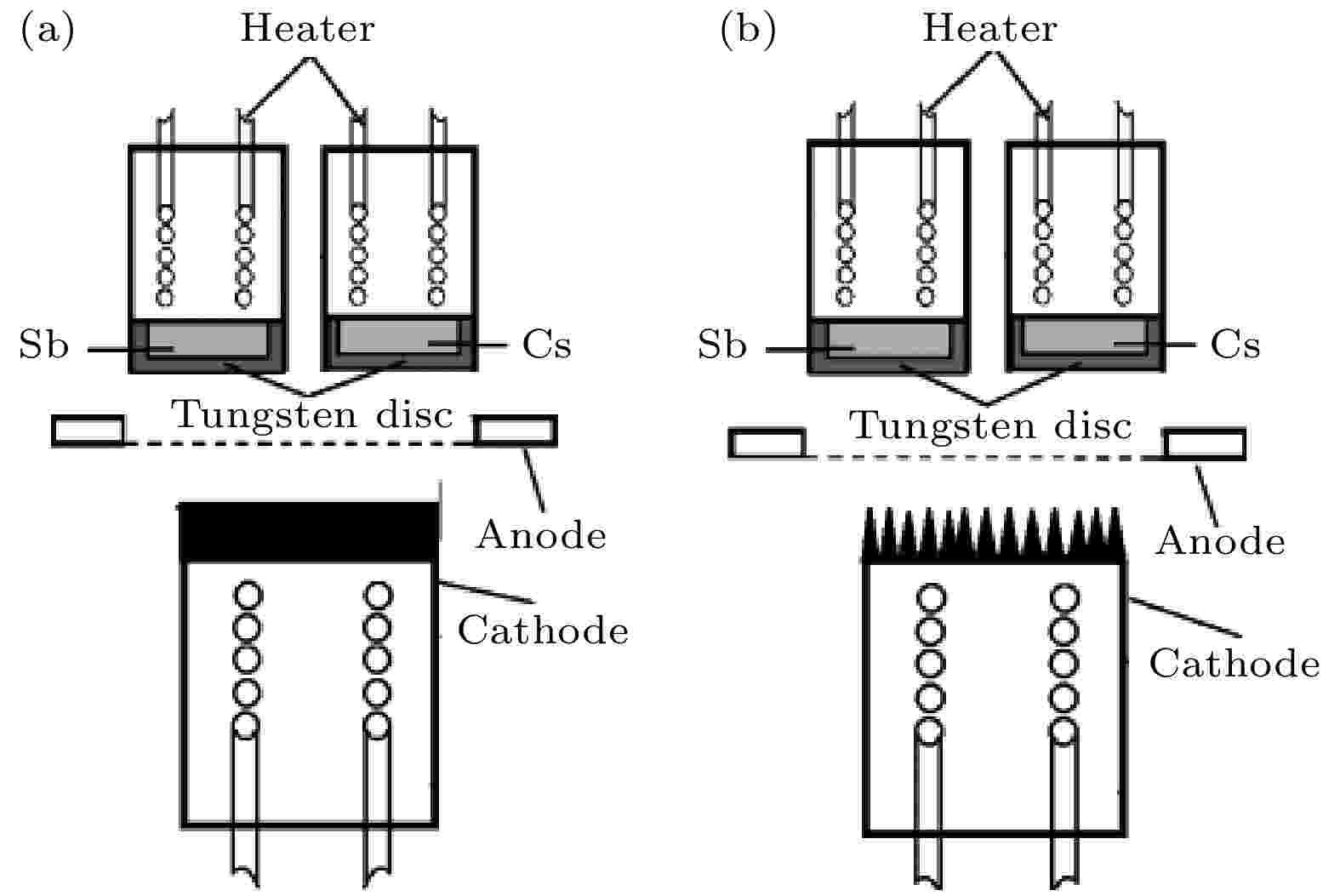
2021, 70 (21): 218503.
doi: 10.7498/aps.70.20210587
Abstract +
To meet the needs of high-frequency, miniaturized vacuum microwave devices, a new photocathode for microwave vacuum electronic device has been studied. Untreated oxygen-free copper, commonly used for photocathode substrate, exhibits relatively high photoemission characteristics. In this paper, we describe a specialized ion-beam bombardment procedure for textured copper surfaces, thereby improving the photoemission properties relative to untreated copper. The emission characteristics of antimony cesium photocathode on oxygen-free copper substrate before and after surface treatment are studied The photoemission and texture of post-treated oxygen-free copper surface are examined by scanning electron microscope. The results show that the treated surface has a particle-free, robust, uniformly highly-textured all-metal structure. This processing technology does not require to modify the copper machining and brazing, nor normal fabrication procedures of other photocathodes. In the experiment, the maximum photoemission current density of photocathode for the untreated substrate is 60.5 and that for the treated substrate is 146.0 mA/cm2, and their corresponding quantum efficiencies are calculated to be 2.67 × 10–3 and 1.71 × 10–2, respectively. So, the quantum efficiency is enhanced by 6.41 times. The analysis indicates that the improvement of the quantum efficiency of the treated photocathode is mainly due to the enhancement of the light absorption rate. The results show that the photoemission is enhanced significantly after the substrate has been treated, and there is still much room for improvement.
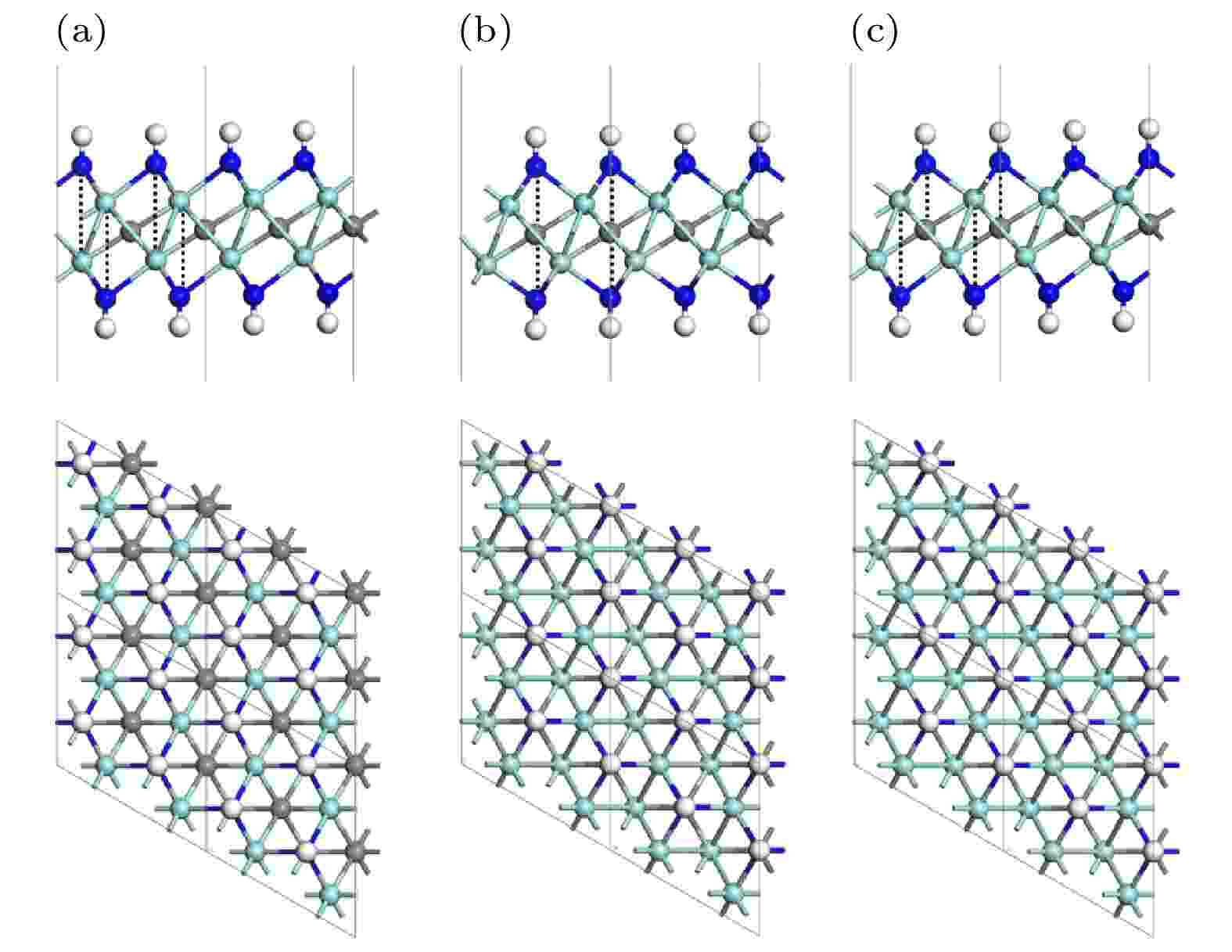
EDITOR'S SUGGESTION
2021, 70 (21): 218504.
doi: 10.7498/aps.70.20210956
Abstract +
The alkali-based semiconductor cathodes, such as Cs3Sb that possesses high quantum efficiency, low electron emittance and short spectral response time, can be considered as ideal next-generation electron sources. However, the alkali-based emitters are found to be sensitive to the oxygen gases, which causes a series of problems such as structural instability, short lifetime, and reduced electron emitting efficiency. It is known that the employing of the ultra-thin layered two-dimensional (2D) materials to protect Cs3Sb basement can promote the development of novel cathodes with excellent performances. However, there is a lack of efficient 2D materials to maintain low work-function (W ) and high quantum efficiency. Recently, the MXene materials which contain layered transitional metal carbides, nitrides and carbonitrides, have attracted great attention particularly in the fields of catalysis and energy. Notably, their flexible types of dangling bonds can lead to tunable structural and electronic properties of MXene-based materials. Here in this work, the MXene-Cs3Sb heterostructures are modeled by using home-made script and systematically investigated by using first-principle calculations based on density functional theory. Further, the effects of transitional metal element (M), M/C ratio, stacking configuration and types of dangling bonds on the calculated W of heterostructures are studied. The result indicates that the type of dangling bond shows a more pronounced effect, and the MXene-Cs3Sb heterostructures with —OCH3/—OH possess lower W than other dangling bonds. The charge density difference and band alignment analysis are further used to illustrate the underlying reason for the change of W. And it is found that interlayer charge redistribution can result in different surface dipole directions, and thus emitting electrons with varying barriers. After computational screening based on the change of W, the M2C(OH)2 (M = V, Ti, Cr) and M2C(OCH3)2 (M = Ti, Cr, Nb) can be potentially considered as ideal coating materials, and especially for V2C(OH)2-Cs3Sb (W = 1.602 eV) and Ti2C(OCH3)2-Cs3Sb (W = 1.877 eV) with significantly reduced W. Finally, we believe that this work can not only give an in-depth insight into the electronic and optical properties of Cs3Sb-MXene heterostructures, but also provide the useful criteria for the computational screening of superior cathodes. Meanwhile, we further urgently expect the cooperative efforts from an experimental perspective to demonstrate the superior performances of those screened MXene-Cs3Sb photocathodes for practical applications.
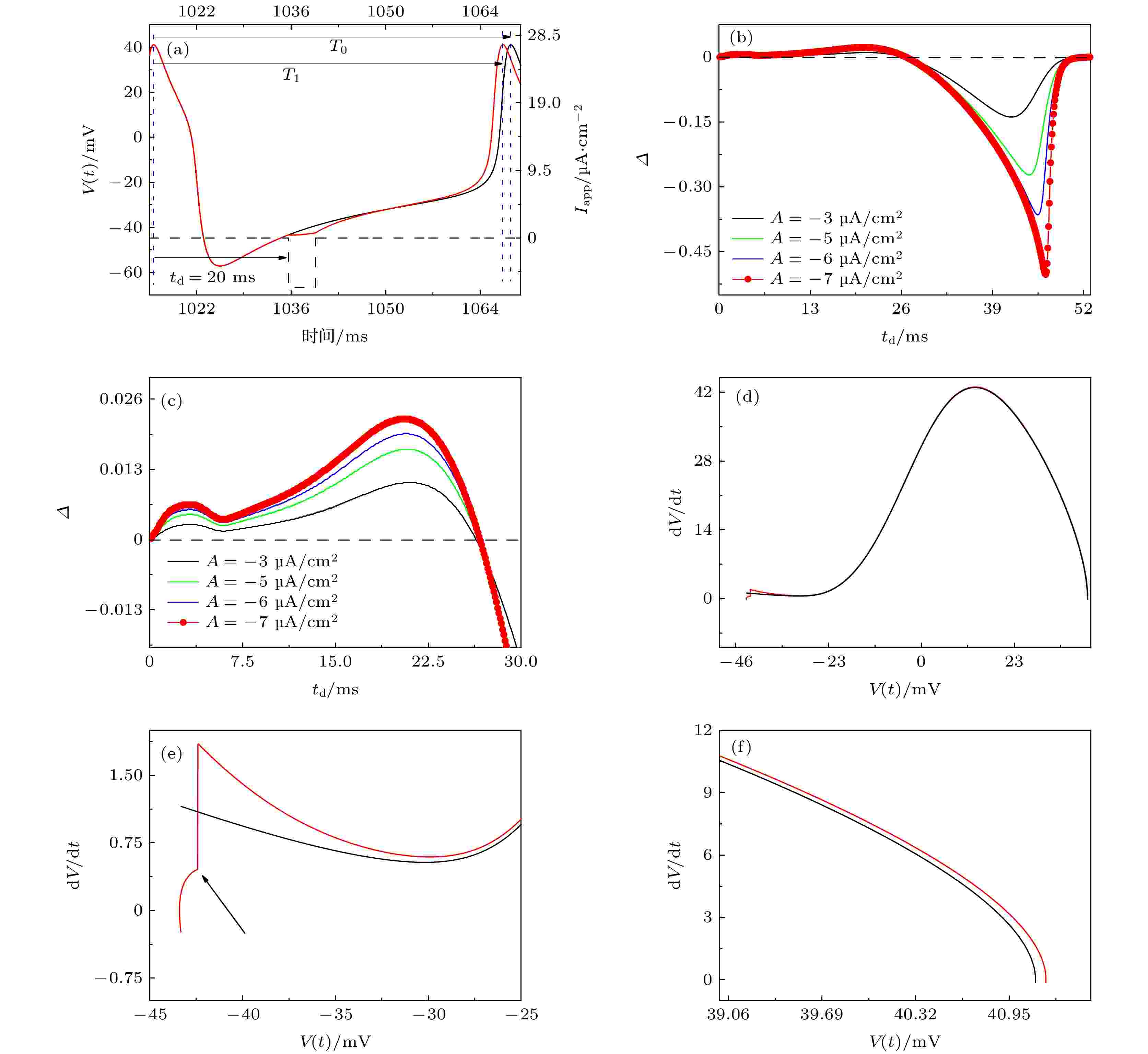
2021, 70 (21): 218701.
doi: 10.7498/aps.70.20210912
Abstract +
Anticipated synchronization, the response of the driven subsystem which appears earlier than the stimulation from the driving subsystem, is a universally counterintuitive nonlinear behavior. This behavior is also observed in the experiment on the nervous system in different brain regions. In the present paper, the anticipated synchronization phenomenon evoked by the inhibitory autapse is simulated in the coupled system composed of Morris-Lecar model, and the condition of excitability of single neurons and parameter ranges for the anticipated synchronization is presented. For a coupled system composed of two neurons, whether both neurons are either type-I excitability/Hopf bifurcation or type-II excitability/saddle-node bifurcation on an invariant cycle, in a driven neuron unidirectionally receiving the excitatory synaptic current from a driving neuron the delayed synchronization (the response of the driven neuron appears after the drive of the driving neuron) instead of the anticipated synchronization is simulated. After the inhibitory autapse is introduced into the driven neuron, the anticipated synchronization can be simulated in the coupled neurons when both neurons are of type-II excitability. With the increase of the conductance of the inhibitory autapse, the transition from delayed synchronization to anticipated synchronization is simulated. The time interval between spike of the driving and driven neuron is acquired, and the parameter ranges of anticipated synchronization in the plane of conductance of the inhibitory autapse and excitatory synapse are obtained. However, if both neurons are of type-I excitability, only delayed synchronization is simulated for the driven neuron with inhibitory autapse. Furthermore, the appearance of anticipated synchronization for type-II neurons and no anticipated synchronization for type-I neurons are suggested to have a relationship between the different responses of firing to external inhibitory stimulation for neurons with type-II excitability and type-I excitability. For spiking of type-II neuron, when an inhibitory pulse stimulation is applied, the spike following the pulse appears earlier than the one in the absence of stimulation in a wide range of the stimulation phase. However, for spiking behavior of type-I excitability, the spike following an inhibitory pulse stimulation appears later than the spike in the absence of stimulation. The results present the condition of single neurons for the appearance of anticipated synchronization induced by the inhibitory self-feedback mediated by autapse, which is helpful for understanding the dynamics of the counter-intuitive behavior, anticipated synchronization, presenting possible measures to modulate the anticipated synchronization, and proving directions for further study of anticipated synchronization.
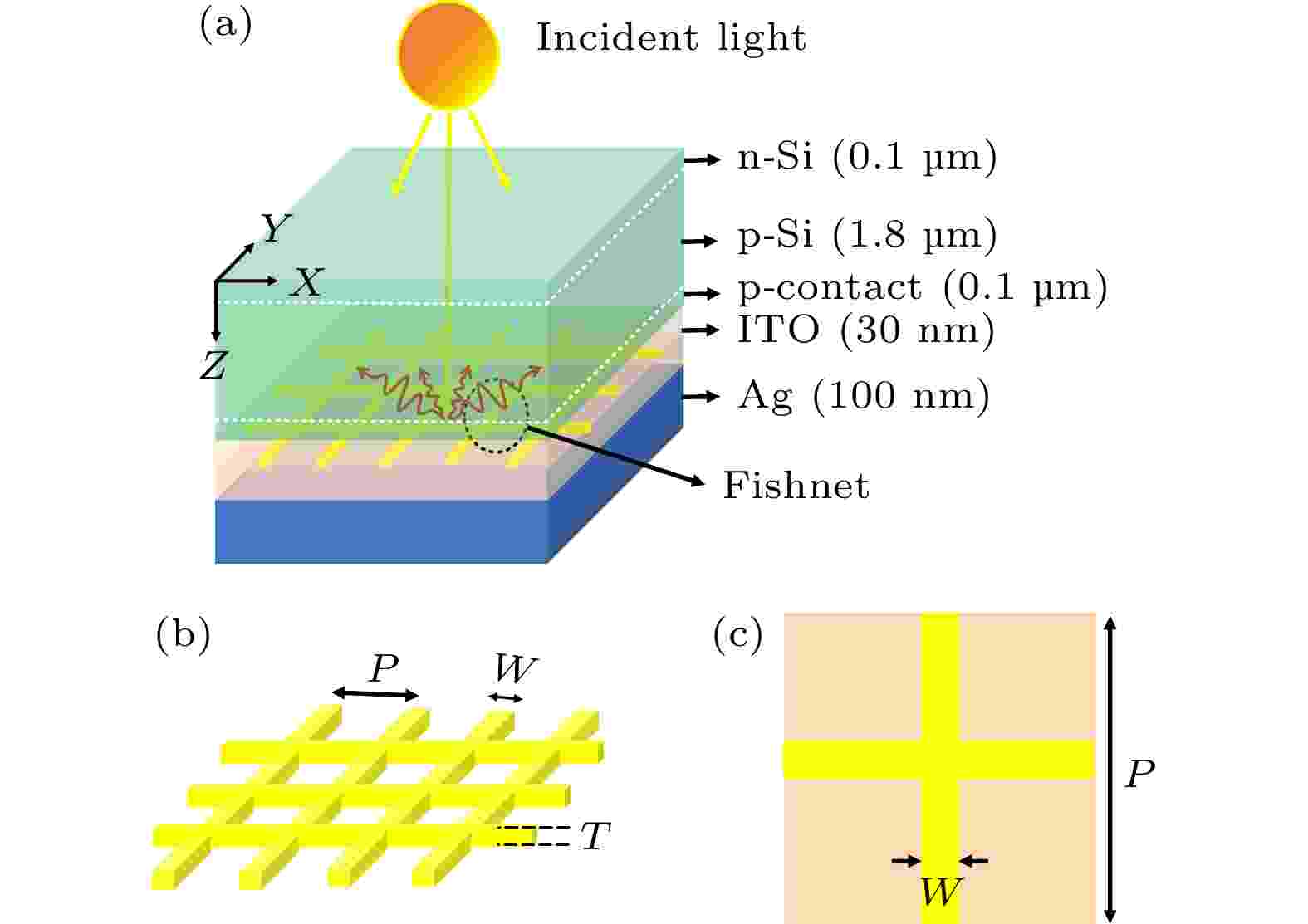
2021, 70 (21): 218801.
doi: 10.7498/aps.70.20210693
Abstract +
The fishnet metastructure has plane, near-optical lossless characteristic, and can excite surface plasmons in a specific light field. It has great potential in enhancing the response efficiency of photonic devices. Based on the finite difference time domain method and rigorous coupled wave analysis, in this paper, we systematically study the plasmon resonance mode of the fishnet metastructure and its light wave regulation performance on the crystalline silicon thin film solar cells. The research results show that the characteristics of absorption, scattering and extinction for the fishnet structure strongly depend on the thickness, line width, period and other characteristic parameters of the metal layer. Through optimizing the design, the resonant peak is red-shifted to 770 nm, and the relative extinction cross-section reaches 1.69, and the scattered light occupies a dominant position in the extinction spectrum. The crystalline silicon thin film solar cell with a response layer thickness of 2 μm constructed in this way has a significantly enhanced absorption efficiency in the wavelength band greater than 800 nm, and the final energy conversion efficiency of the device increases from 6.67% to 8.25%. The light intensity distribution shows that the enhanced backscattering caused by resonance and the large-angle deflection of the photon propagation direction are important reasons for the response gain of the solar cell.
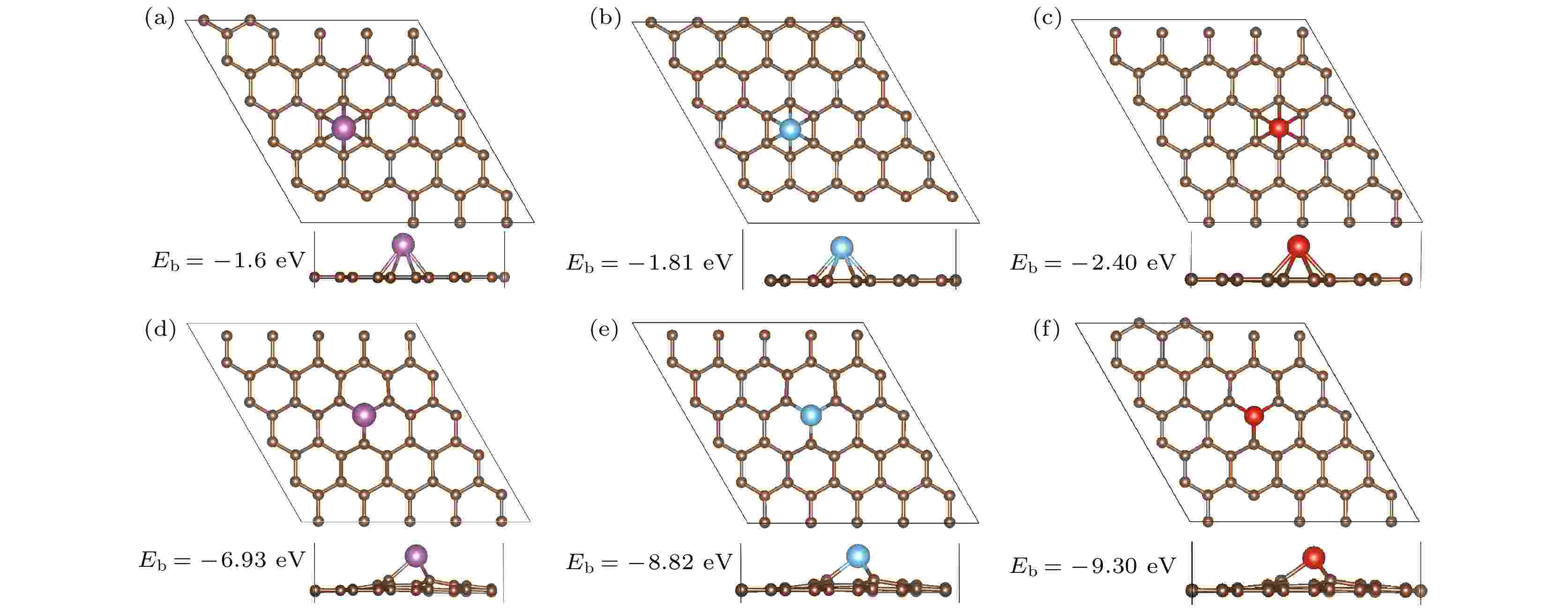
EDITOR'S SUGGESTION
2021, 70 (21): 218802.
doi: 10.7498/aps.70.20210727
Abstract +
With the depletion of fossil fuels and the environmental problems, the development and utilization of new energy resources is imminent. Hydrogen energy is one of the main new energy sources in the 21st century. Finding stable and efficient hydrogen storage materials is the key to achieving the hydrogen economy. Transition metal (TM)-decorated graphenes have been widely studied as hydrogen storage materials theoretically, but they suffer metal agglomeration and H2 dissociation. Our calculations show that the reconstruction energy of Sc, Ti, V decorated pristine graphenes in the process of adsorption and desorption of hydrogen molecules are only 0.00, 0.12 and 0.08 eV, respectively. The adsorption energy values of the first H2 dissociation adsorption on the Sc, Ti, V decorated pristine graphenes are –1.34, –1.34, and –1.16 eV, respectively. So, some hydrogen molecules are difficult to desorb at room temperature and medium pressure. In this paper, the stability and hydrogen storage properties of Sc, Ti, V decorated monovacancy graphene are also investigated based on density functional theory. The results show that the binding energy values between Sc, Ti, V and themonovacancy graphene are –6.93, –8.82, –9.30 eV, respectively, which indicate monovacancy can effectively avoid metal aggregation. The Sc, Ti and V atoms decorated on the monovacancy graphene would transfer more electrons to the carbon material with charge of +1.24|e|–+1.37|e|. They can adsorb 7, 3 and 4 hydrogen molecules through electrostatic interaction. When a monovacancy is introduced, all of the hydrogen molecules are adsorbed in molecular form. The average adsorption energy values of H2 are –0.13, –0.20 and –0.18 eV, respectively, which are in the best energy range for the adsorption/desorption process at room temperature and medium pressure. The most important thing is that their deformations in the adsorption/desorption process are very small, which is conducive to the rapid hydrogen adsorption/desorption. The calculated results show that the monovacancy introduction can effectively solve the two major problems, i.e. metal agglomeration and hydrogen molecular dissociation during hydrogen storage on Sc, Ti, V decorated pristine graphenes. The research in this paper will be helpful to further understand the hydrogen storage mechanism of 3d TM-decorated carbon nanomaterials.
GEOPHYSICS, ASTRONOMY, AND ASTROPHYSICS

2021, 70 (21): 219101.
doi: 10.7498/aps.70.20210884
Abstract +
Absolute gravimeter, an instrument which is applied to laser interferometry or atom interferometry for measuring the gravitational acceleration g (approximately 9.8 m/s2), plays an important role in metrology, geophysics, geological exploration, etc. To achieve a high accuracy of several microGals (μGal, 1μGal = 1 × 10–8 m/s2), a vertical vibration isolator is widely employed in the absolute gravimeter to protect the reference object (a retro-reflector or a mirror) from being disturbed by ground vibration noises. However, the reference object in vibration isolator may still move due to isolator’s response to the impulse caused by the self-vibration effect in laser-interferometry gravimeter, or the forced vibration of the ferromagnetic component in the isolator under the varying magnetic field of magneto-optical traps (MOTs) in atom-interferometry gravimeter. This vibration of the reference object has a fixed phase relative to the detection of the free-fall of a falling object or atoms, leading an additional systematic error to be introduced into measured g value. In this paper, the physical models of four typical vertical vibration isolators used in the current absolute gravimeters are introduced, i.e. a passive Minus K isolator, a passive Lacoste isolator, a one-stage active isolator, and a double-stage active isolator. The simulation models of these isolators are also created with specific resonance periods. Taking a laser-interferometry gravimeter for example, the responses of these isolators under impulse input are analyzed, proving that the real vibration of the reference object, namely the output of each isolator, has a fixed phase relative to the detection of the fringe signal, which indicates the trajectory of the free-falling object, hence resulting in an additional systematic error. To provide a detailed evaluation, firstly the vibration of the reference object under an impulse, a seismic noise, and a random noise, which represent typical ground vibrations, are obtained by running the simulation. Then the corresponding errors in the calculation of g value are presented. Besides, the experimental results of T-1 laser-interferometry gravimeter at a noisy site in Tsinghua University, with either a Minus K isolator or a Superspring isolator used, are compared with the simulated results. According to the above simulations and experiments, the systematic error introduced by the vibration of resonance object in a Minus K isolator or a one-stage active isolator under impulse can respectively exceed 600 μGal or 10 μGal, while the error with the object in a Lacoste isolator or a double-stage active isolator can be neglected. Therefore, it is better to use a double-stage active vibration isolator in absolute gravimeter to avoid this systematic error and achieve higher measurement accuracy. With more information about the forced vibration in the isolators under varying magnetic fields of MOT, the systematic error introduced by the vibration of reference object can also be specifically evaluated in the future.

2021, 70 (21): 219501.
doi: 10.7498/aps.70.20210745
Abstract +
In this paper, CGRaBS J2345-1555’s long-term radio band, gamma ray flux and optical V-band magnitude data are collected from Fermi/LAT, Catalina, and OVRO dataset. The correlation between multi-bands is evaluated by the discrete correlation function method. The results show that the correlation coefficient between gamma band and radio band is 0.53, and the time delay is about 90 days, a variation of the gamma band is about 90 days ahead of radio band; the correlation coefficient between radio band and optical V-band is 0.84, and the time delay is about –300 days, a variation of the optical V-band is about 300 days ahead of radio band; there is no significant correlation between gamma and optical V-band. These results show that the optical band is dominated by synchrotron radiation, and the time delay between the radio band and the optical band can be explained as the fact that the radiation region of the optical band is upstream, and the radio band is downstream. The gamma band and the radio band are both homologous. The distribution of brightness temperature is used to calculate the Doppler factor of the celestial body’s radio band. The averaged Doppler factor is 12.64, and it oscillates with the light curve. So the jet has obvious bunching effect, and the variation of radiation flux in radio band comes from the jet.








